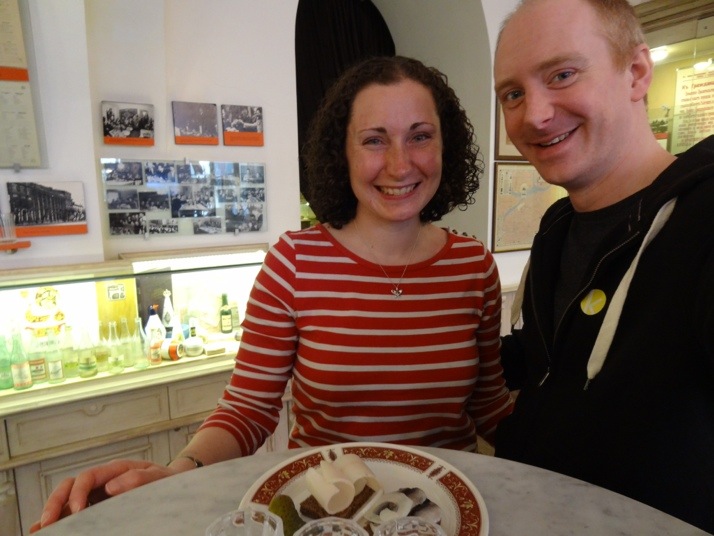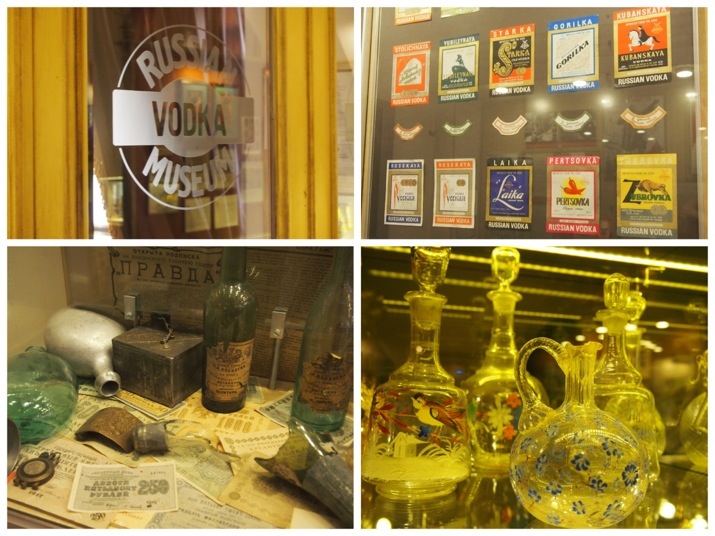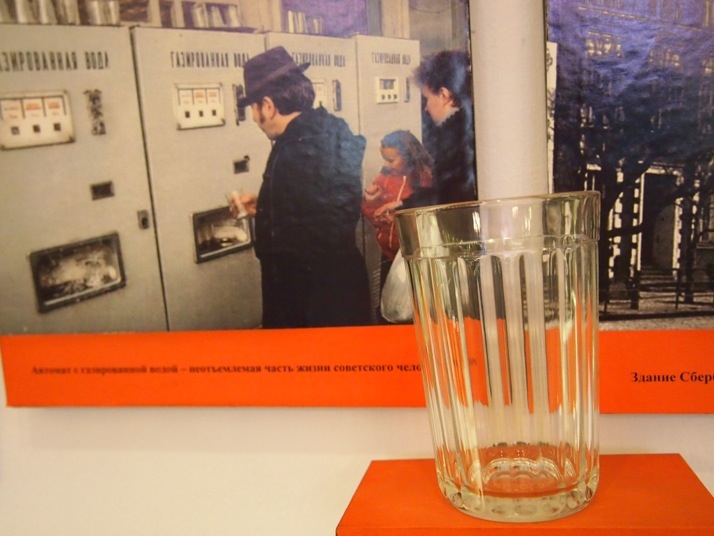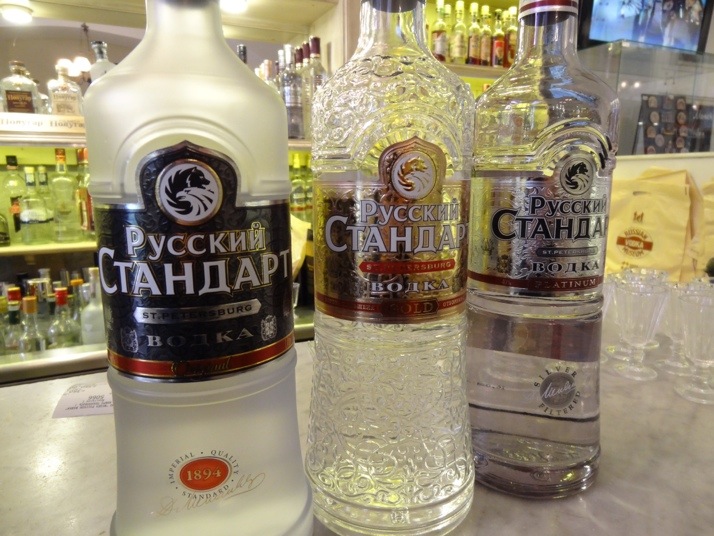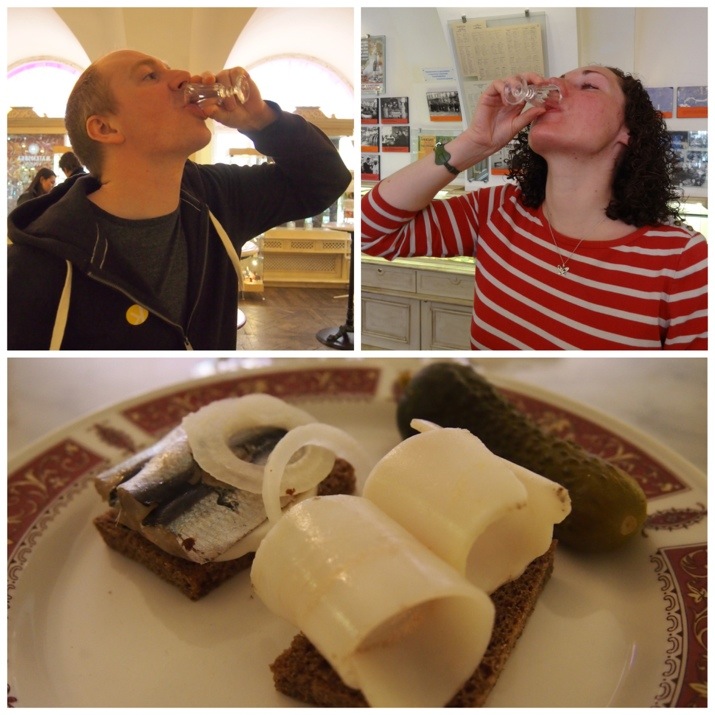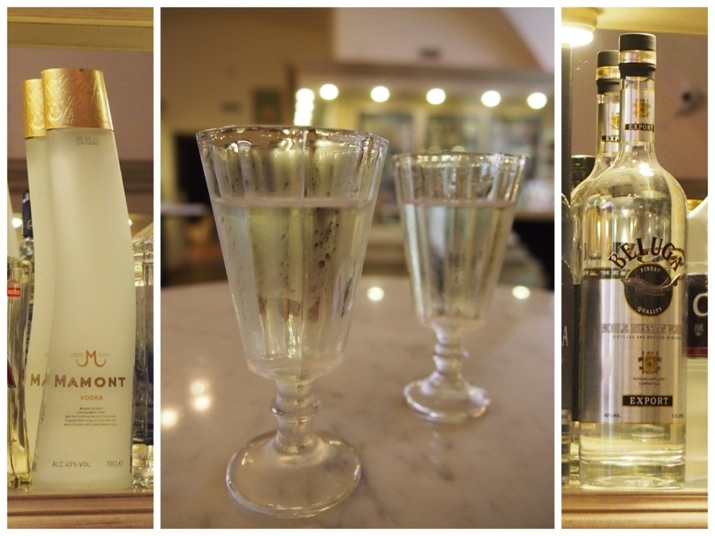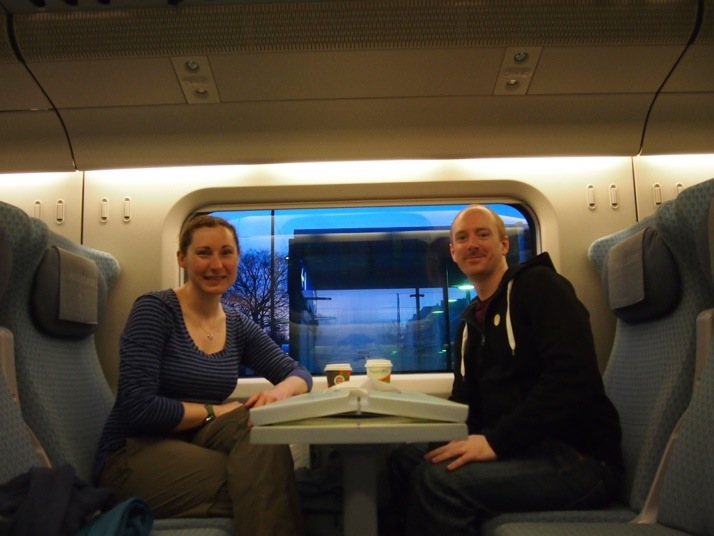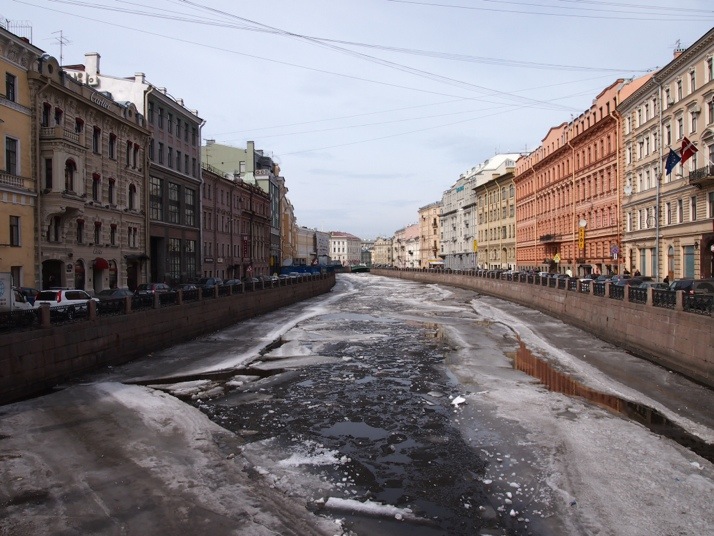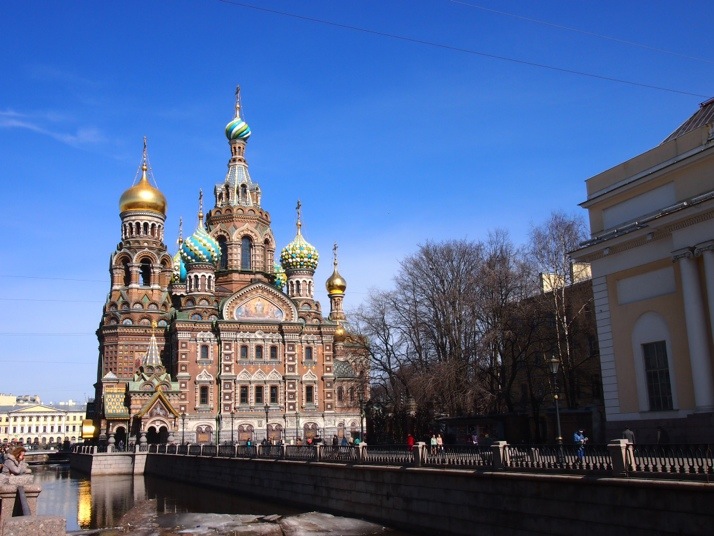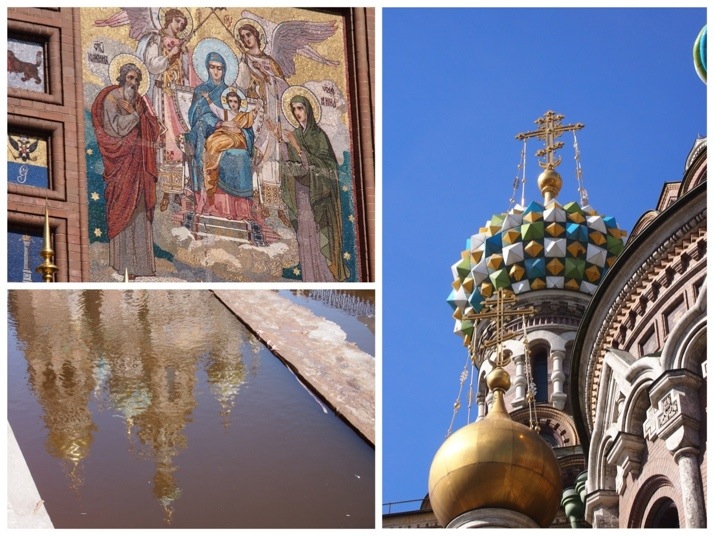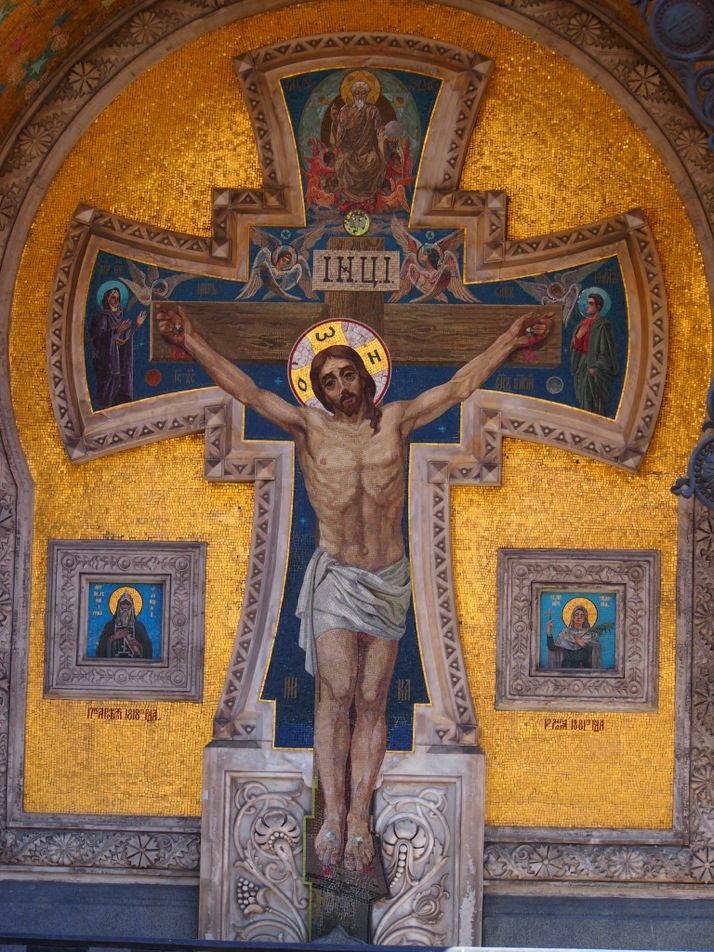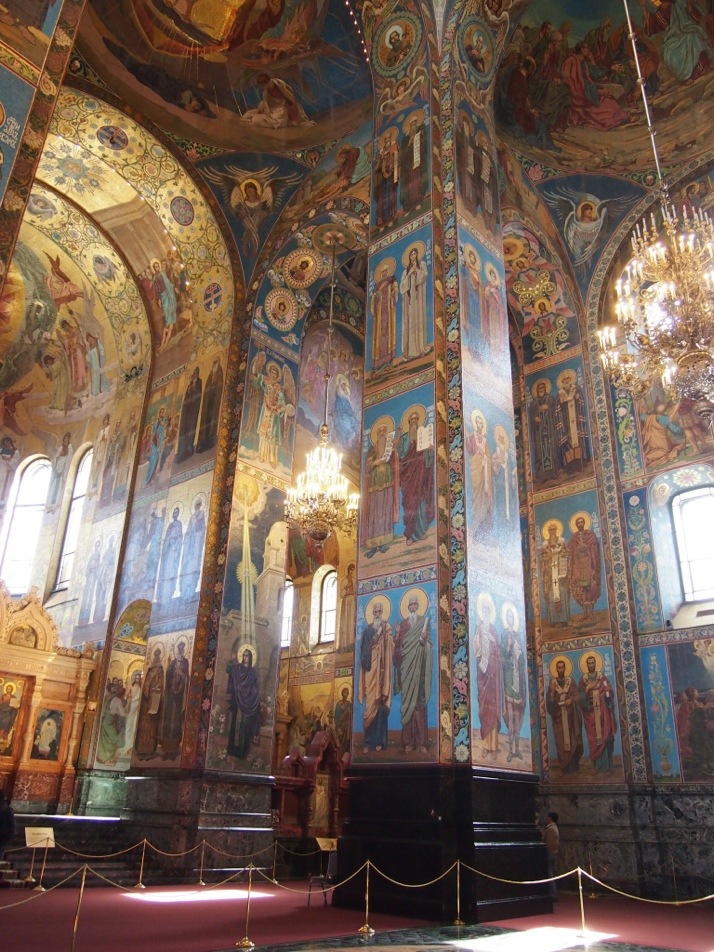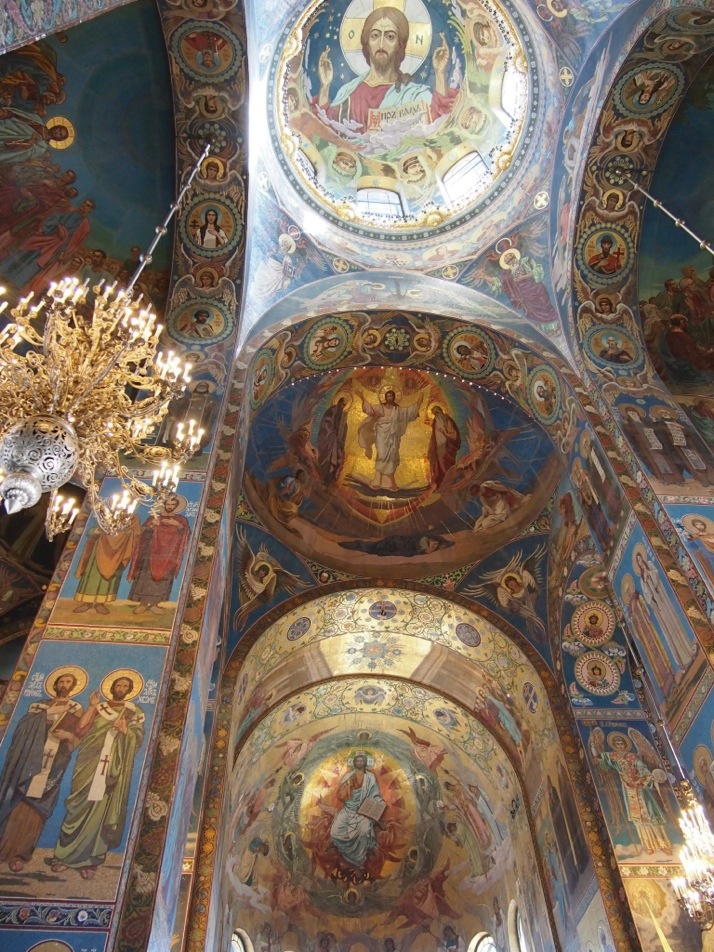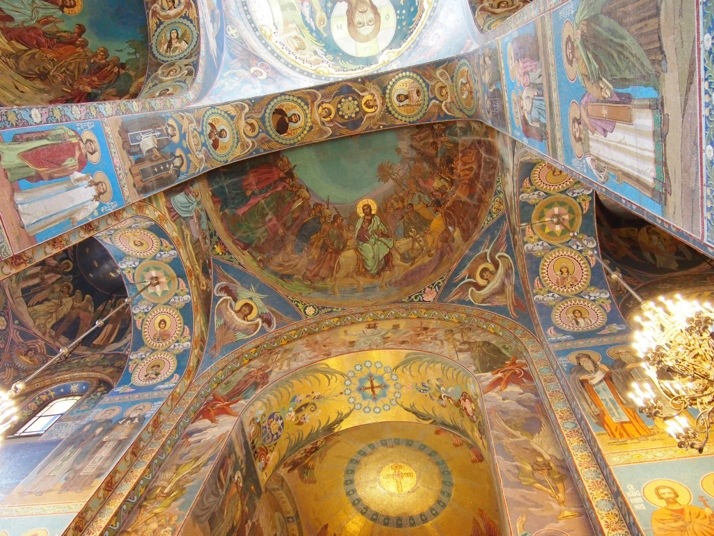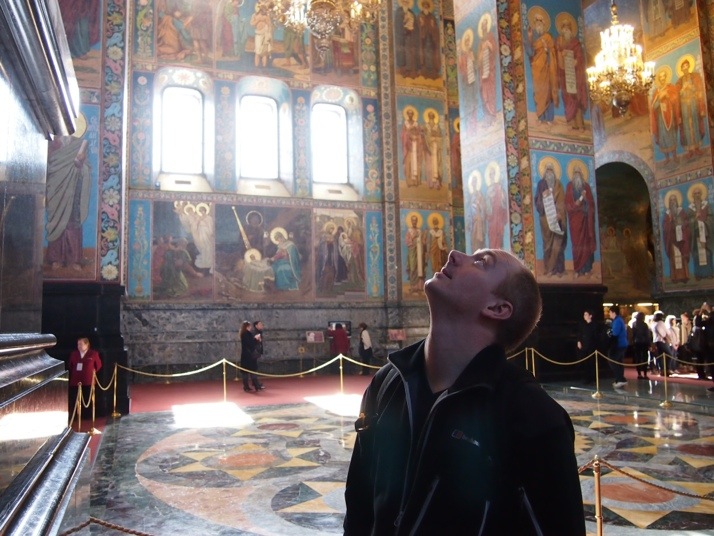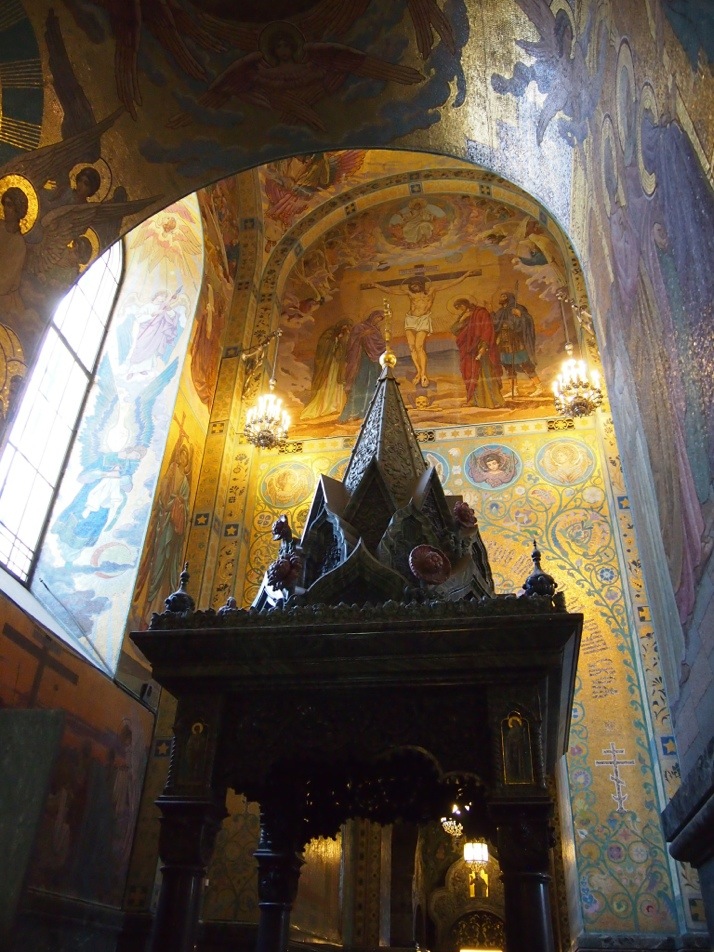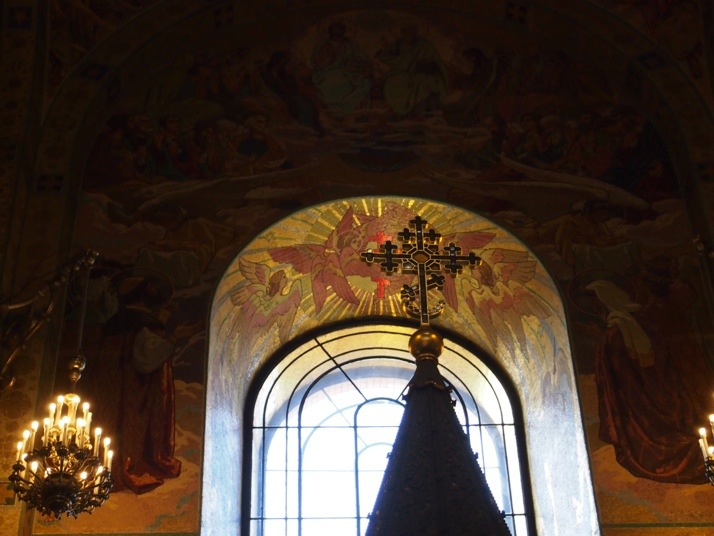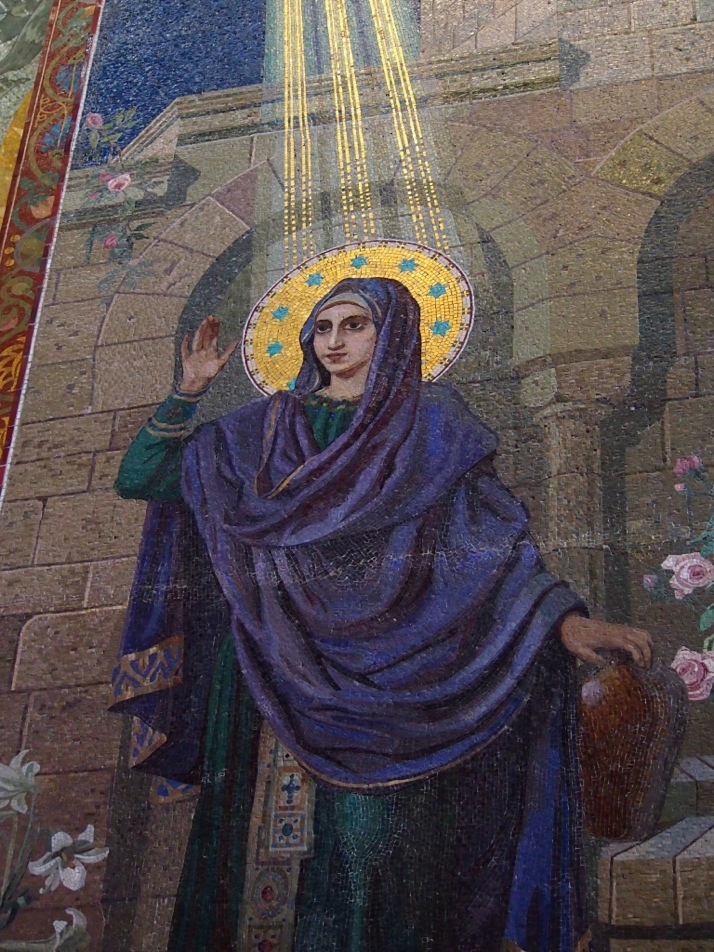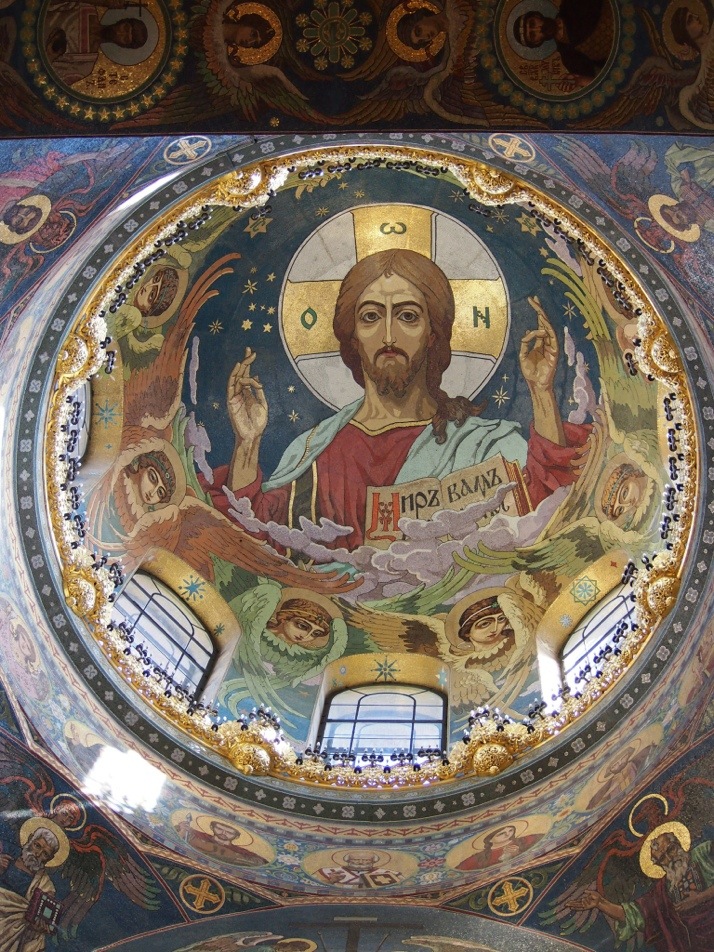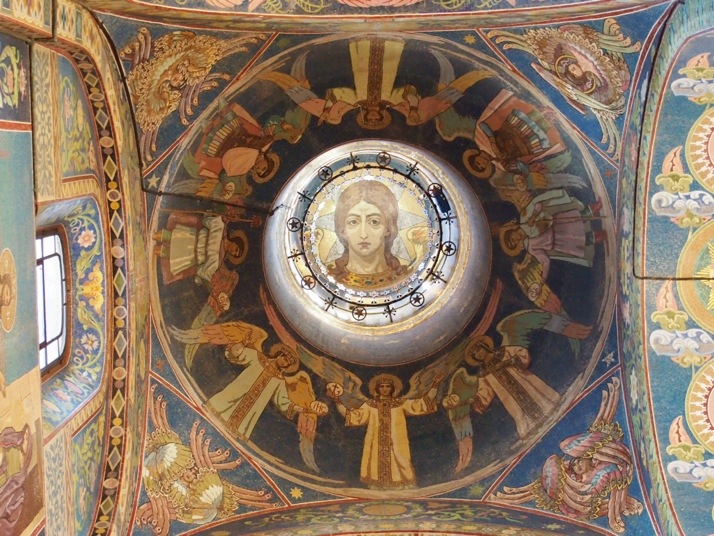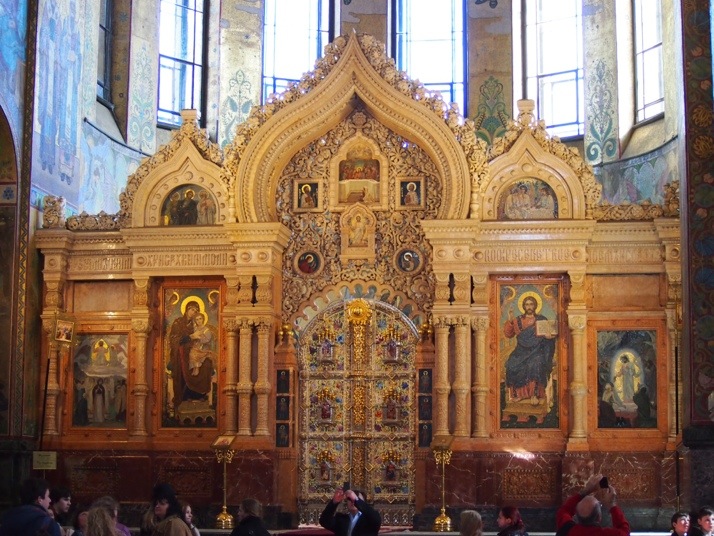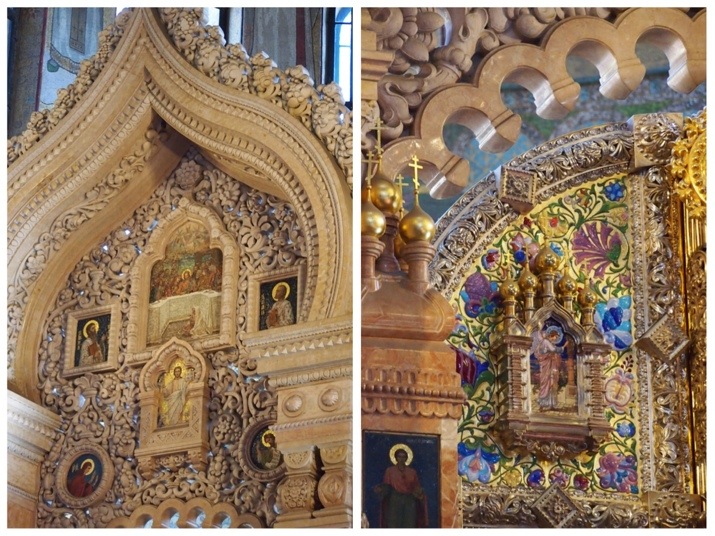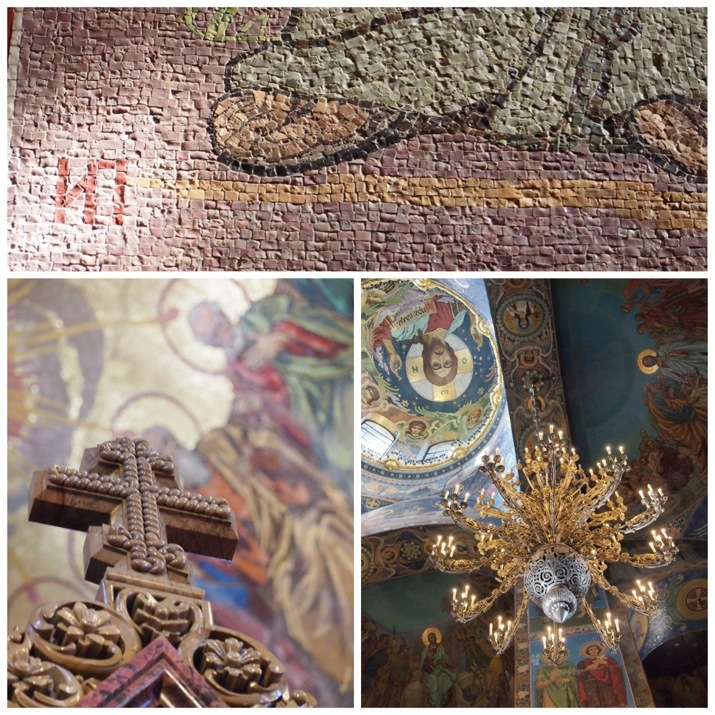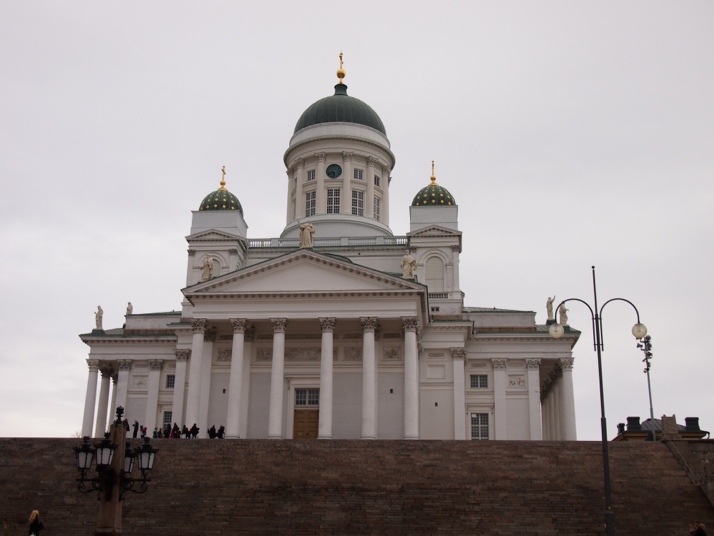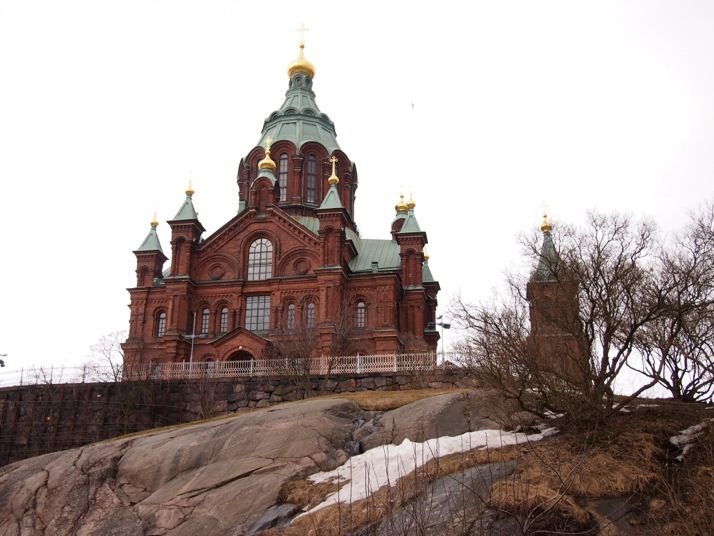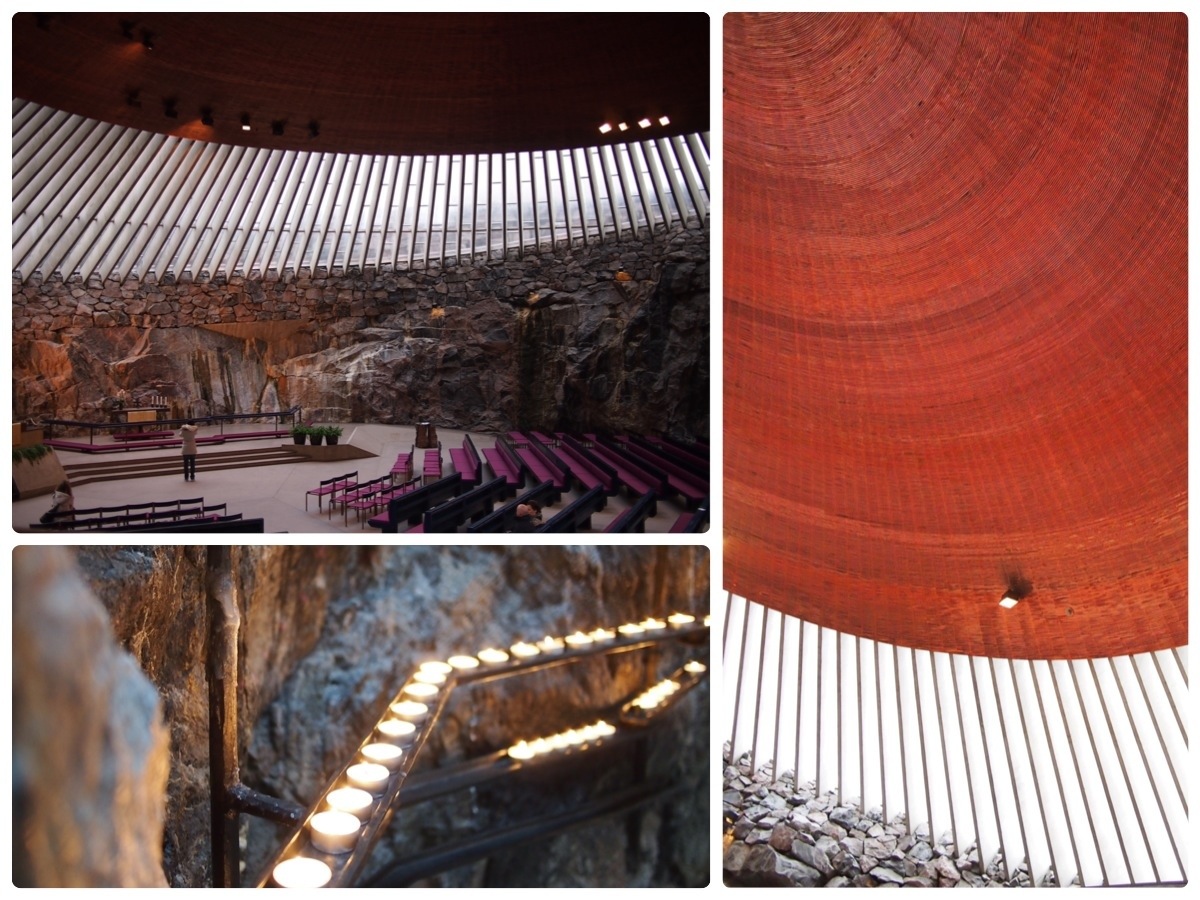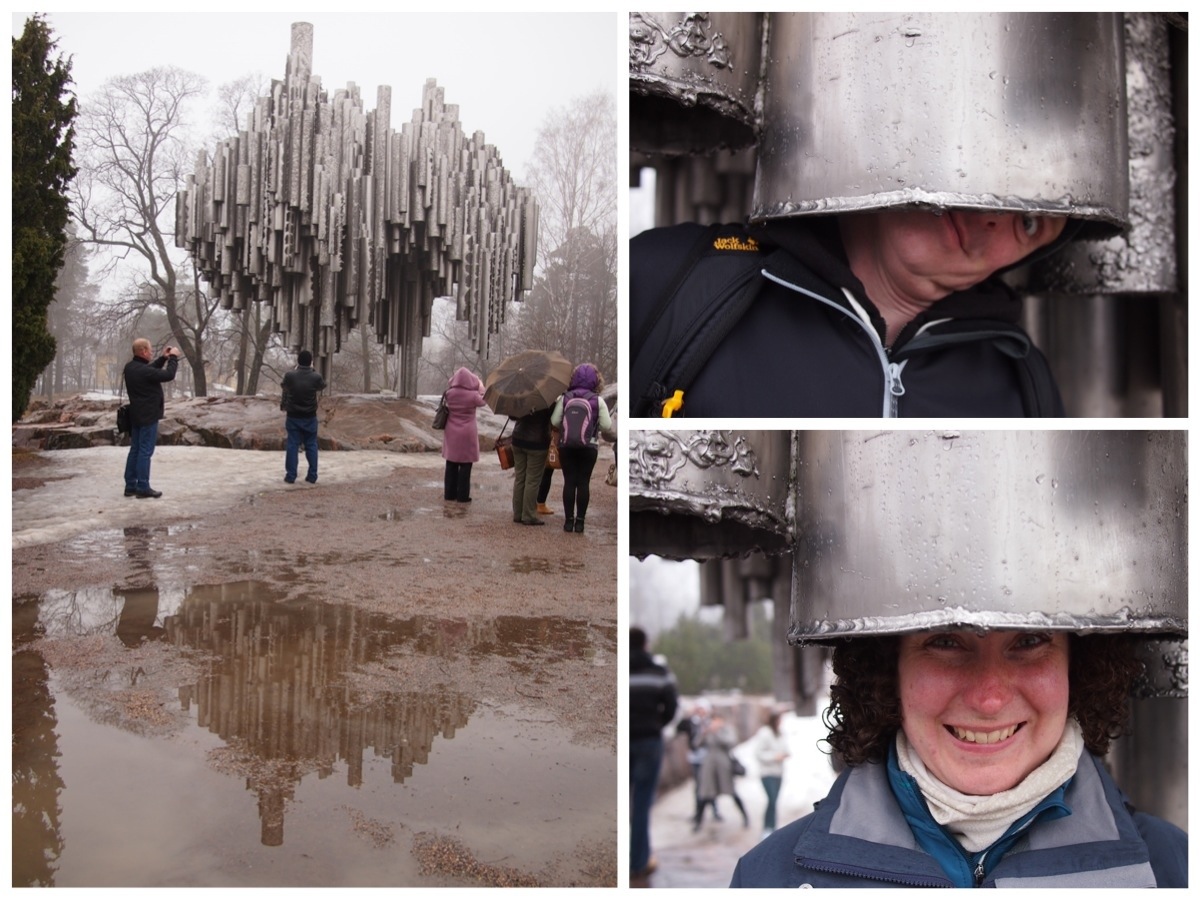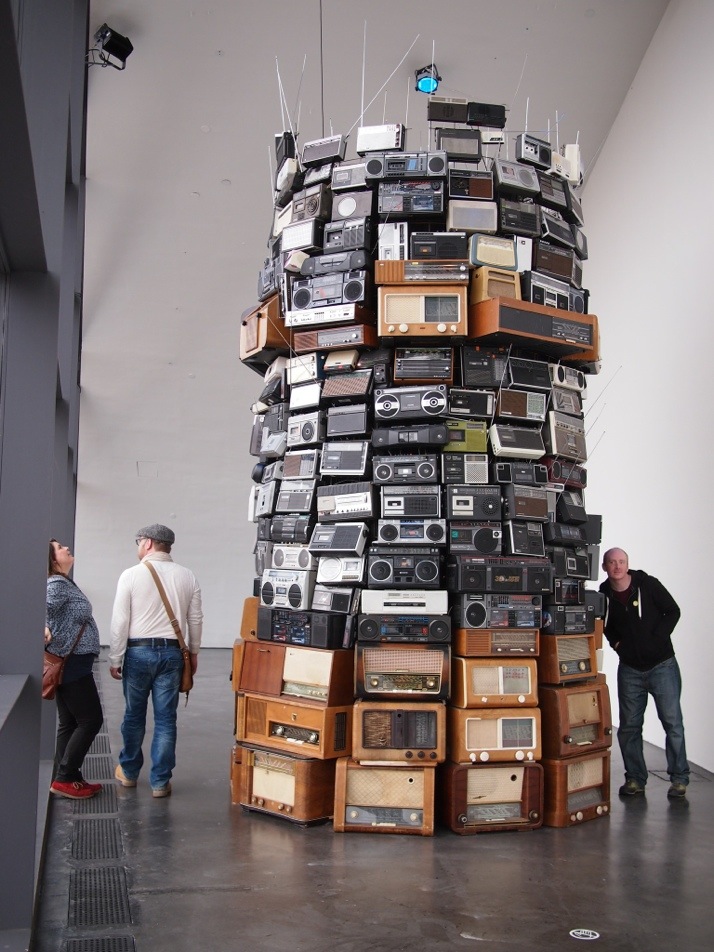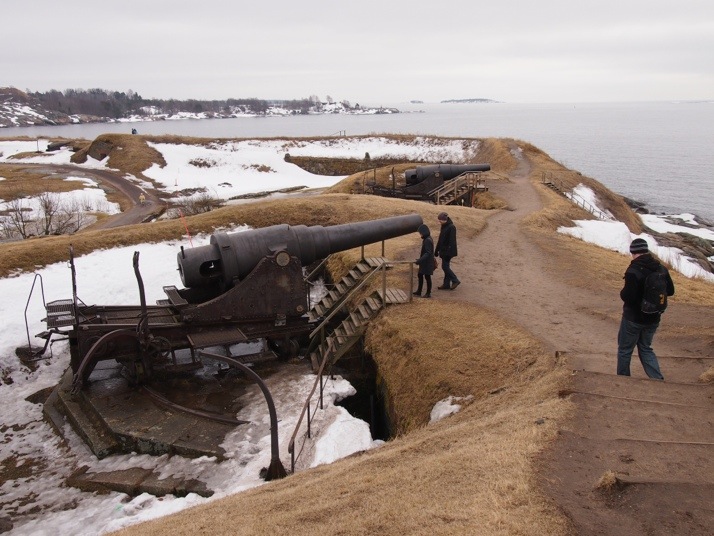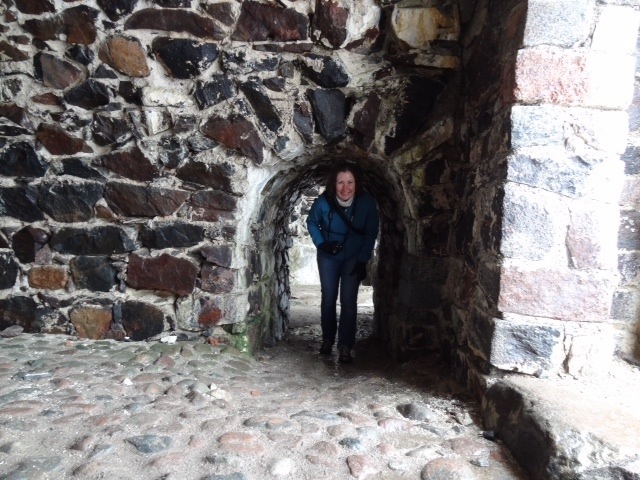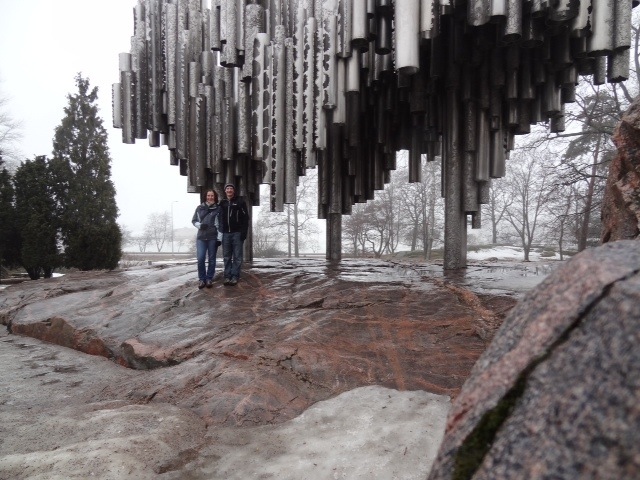I know we’ve posted a round-up of our time in Estonia without posting details of what we’ve been up to, but that’s because we were busy getting up to stuff!
Tartu
Estonia’s “second” capital, where their independence was signed in 1920, is also its biggest University town. Think Cambridge or Oxford, crossed with the cobbled streets of York. Lovely..
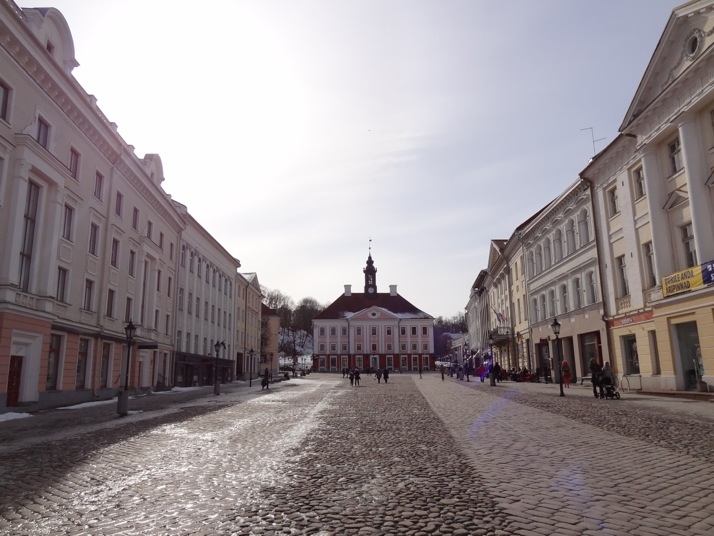
Tartu town hall, our hostel is half-way up the main square (Raekoja plats) on the right – a perfect location
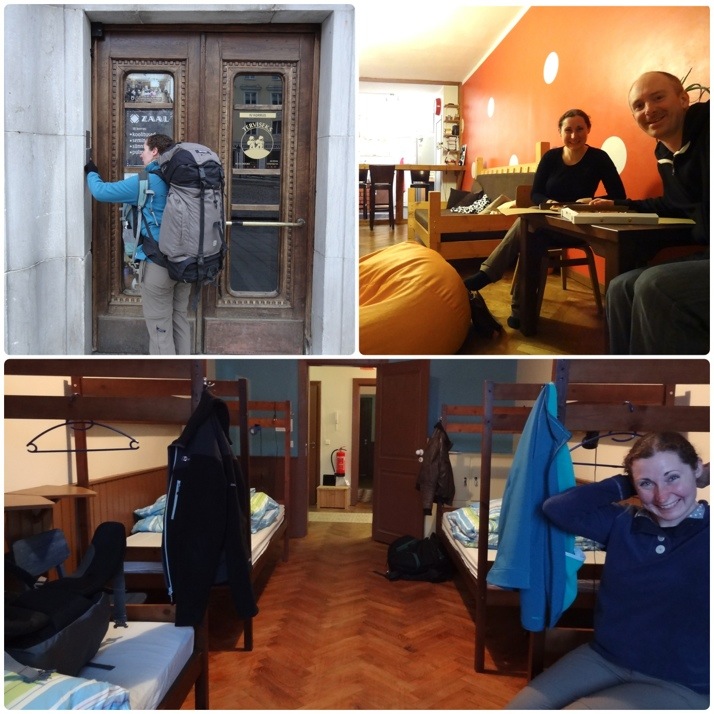
After checking in to our 4-bed dorm room, we headed out for pizza as it was getting dark, and well, our journey getting here hadn’t gone quite according to plan.
Next morning we woke up to a miserable sleety-snowy kind of a day, so we decided to spend as much of it indoors as we could. First up, time for a wander to the market for some provisions..
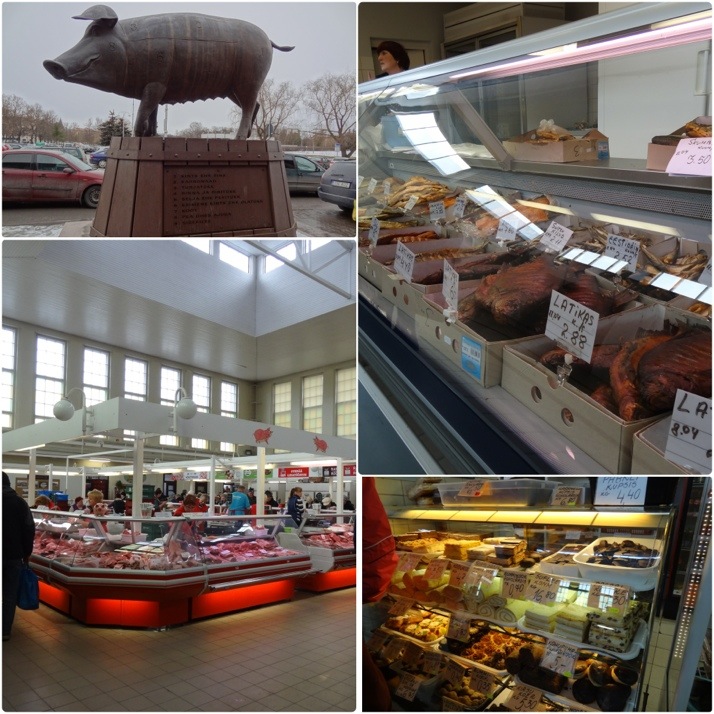 Tartu indoor market. The pig outside sets the tone – most stalls sold pork, with 2 beef stands (that we saw), fruit, veg and sweet stuff on the periphery, and a small hall for fish – the most popular were small fish by the scoopfull!
Tartu indoor market. The pig outside sets the tone – most stalls sold pork, with 2 beef stands (that we saw), fruit, veg and sweet stuff on the periphery, and a small hall for fish – the most popular were small fish by the scoopfull!
After dropping our food back at the hostel, we headed to the University, as we’d read about the old “lock up” – a solitary confinement in the attic for badly behaved students of yesteryear. How badly behaved you ask? Failing to return library books on time netted you two days; insulting a lady, four days; insulting a (more sensitive?) cloakroom attendant, five days; duelling, up to three weeks!
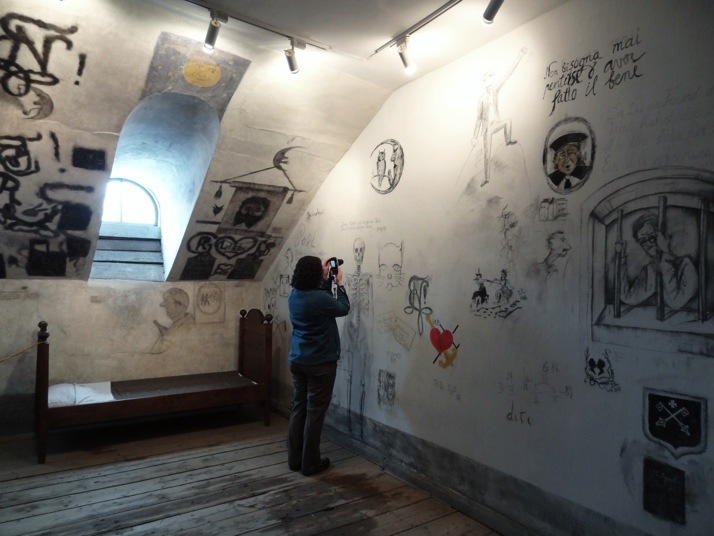
Time for some lunch, and where better than the sandwich shop that hardly ever closes. After walking straight past it and on for another 2 blocks before we almost gave up and went to the supermarket next door, we were justly rewarded for our perseverance.. behold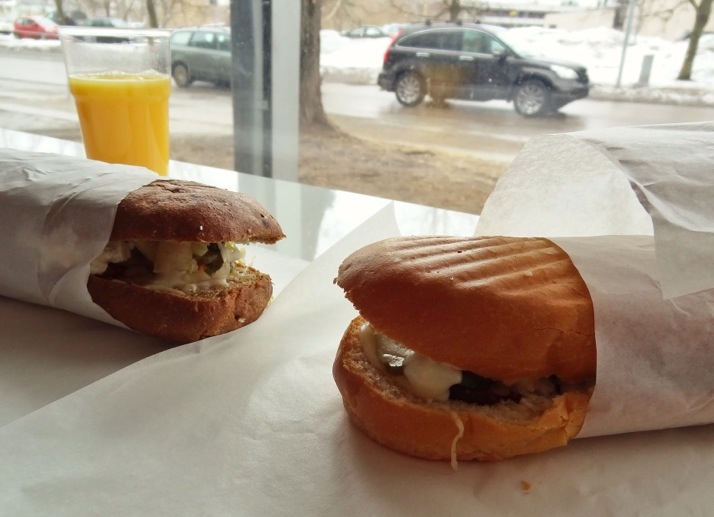 What you can’t see is the place is packed with locals, and there’s a Jean-Claude Van Damme movie playing on the TV.
What you can’t see is the place is packed with locals, and there’s a Jean-Claude Van Damme movie playing on the TV.
The rest of the afternoon was spent in the Aura swimming pool and water park – two flumes, a lazy river and an Olympic-sized swimming pool. After sitting in the jacuzzi watching the sleet coming in sideways outside, we headed to the separate his and hers saunas to ensure we were cooked all the through before meeting up and venturing back to the hostel.
The next day we had better weather and decided to see a few of the sights.. Estonian writer Eduard Vilde, Andrew and Oscar Wilde sharing a bench
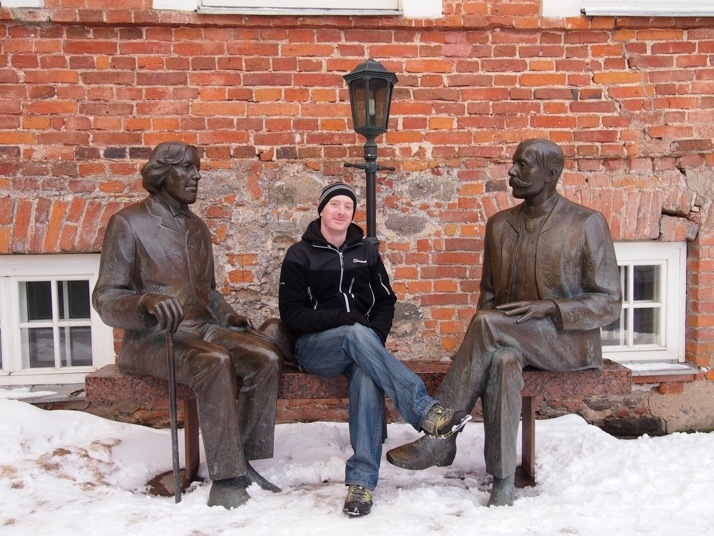
Tartu Cathedral on the top of Töomemägi (literally “Cathedral hill”). The other half of it has been rebuilt and used to be the University Library, but is now the Museum of University History.
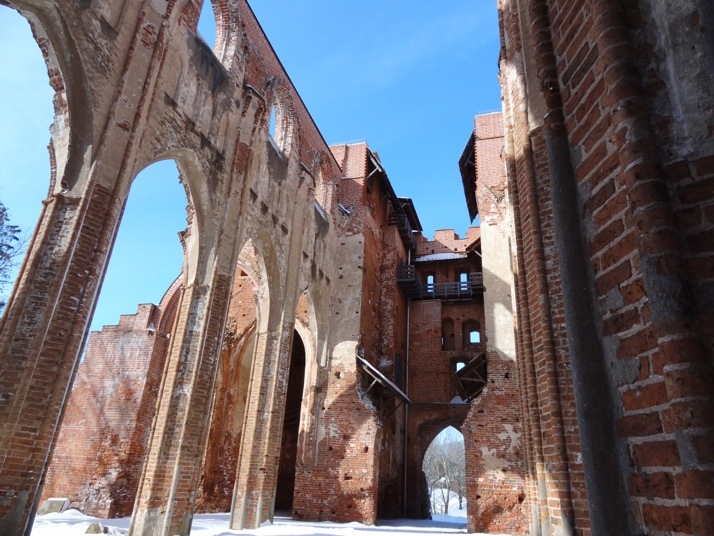
After a wander through the park that surrounds the Cathedral and over the Angel’s bridge (yes, there’s a Devils bridge too!) we headed to the Botanical gardens and greenhouses. On the way was the Jaani Kirik or St. John’s Church, which is a unique Lutheran church in that it has hundreds of terracotta sculptures in its walls:
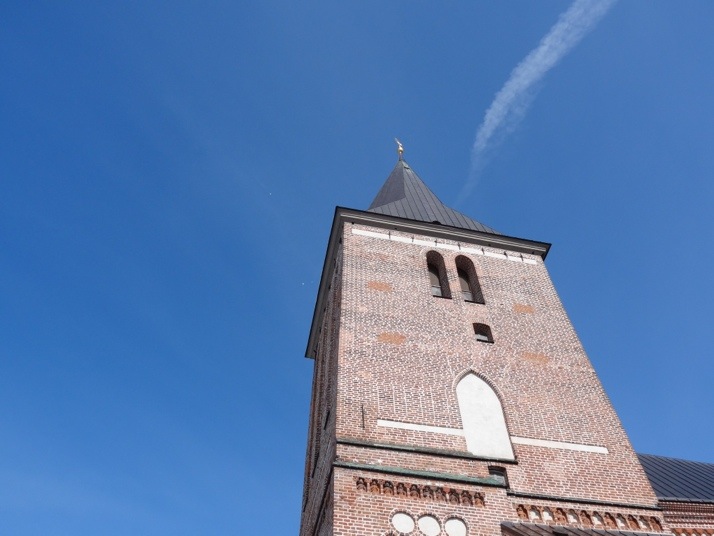 Can you see the snow falling from the roof?
Can you see the snow falling from the roof?
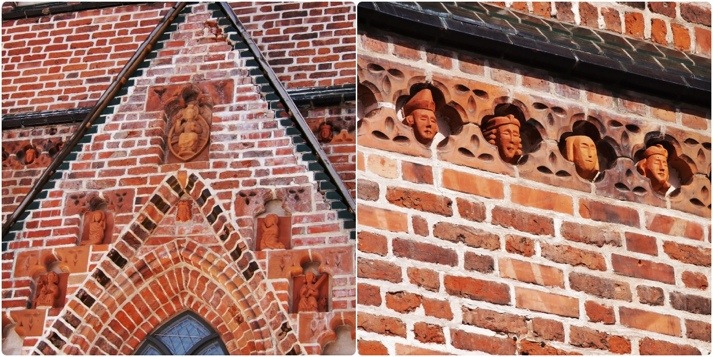 Sadly, the tower was closed as we like aerial views
Sadly, the tower was closed as we like aerial views
As the free Botanical gardens were still covered in snow, we paid the small entrance fee to look through the lovely and warm greenhouses. We took so many photographs that its been hard not to post them all!
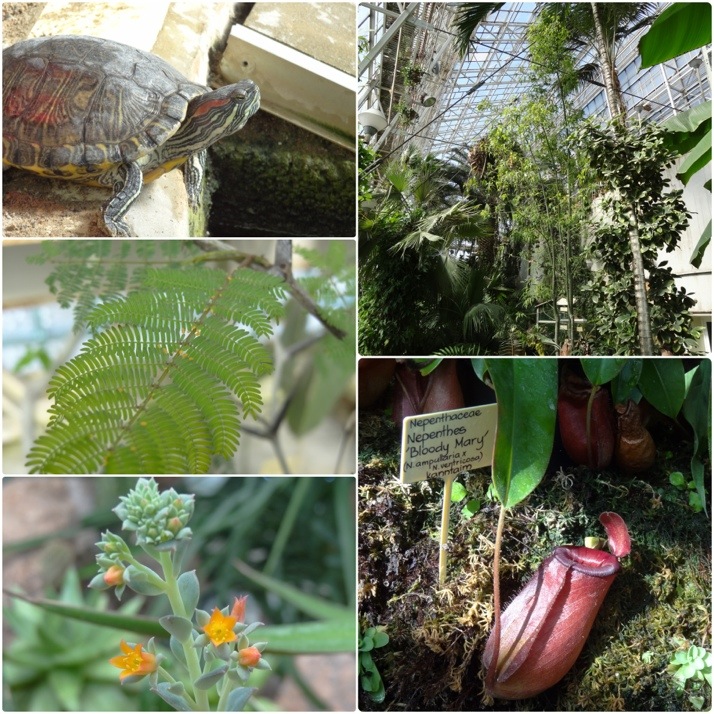
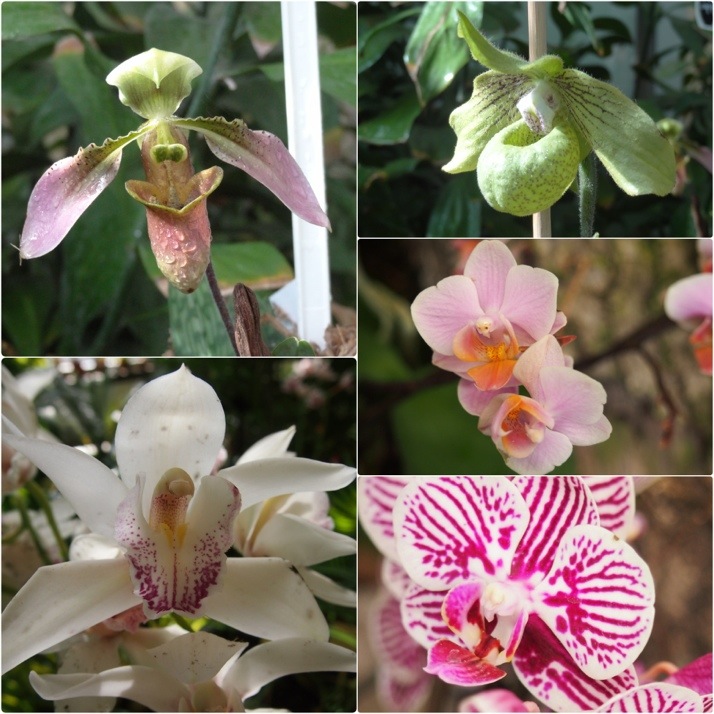 Orchid collection especially for Moi :o)
Orchid collection especially for Moi :o)
All warmed up, we headed back across town to a non-descript gray soviet building, know as the “gray house”. In the 1940’s the house was nationalised, and used by the KGB who had offices on the top floor. Shortly after the Russians left in 1997, the house was returned to the previous owner’s children, who found the basement had been converted into a prison complete with solitary confinement rooms. The new owners turned it over to the Tartu City Museum, and it’s now the KGB Cells Museum.
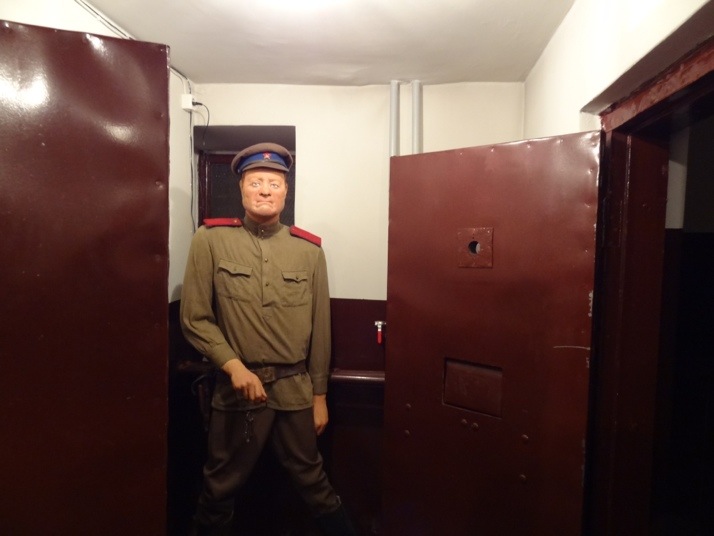
And chilling it is too.. wander too far down the corridor and you trip a recording of an inmate being tortured just as you walk past a restraining chair left by the KGB. The recording ends with a gunshot, and then you find out that as the Nazis forced the Red Army retreat from Tartu in 1941, the KGB executed all of the inmates – 6 bodies were found in the well behind the building. The museum itself details the deportation plans from occupied Estonia, the resistance movement, as well as the dark history of the gray house itself.
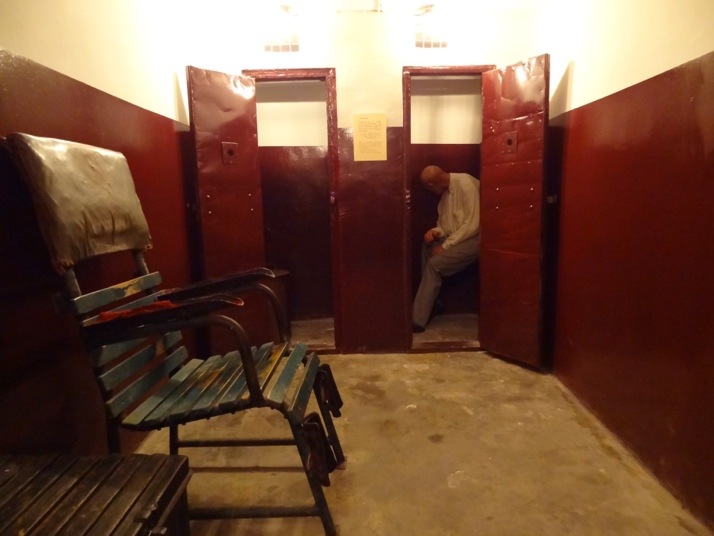 Torture chair left by the exiting KGB, and 2 solitary confinement rooms.
Torture chair left by the exiting KGB, and 2 solitary confinement rooms.
Time for a drink!
In the side of Töomemägi is an old cavernous gunpowder cellar that serves beer in the style of the German Oktoberfest.. perfect!
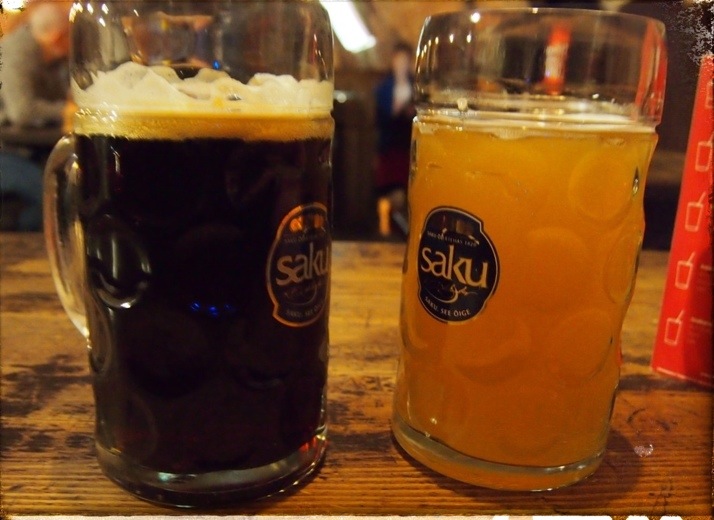 For €100 you can have your own tankard put on a peg behind the bar too.. I was very tempted..
For €100 you can have your own tankard put on a peg behind the bar too.. I was very tempted..
For our last day in Tartu we decided to go for a walk along the river Emajõgi
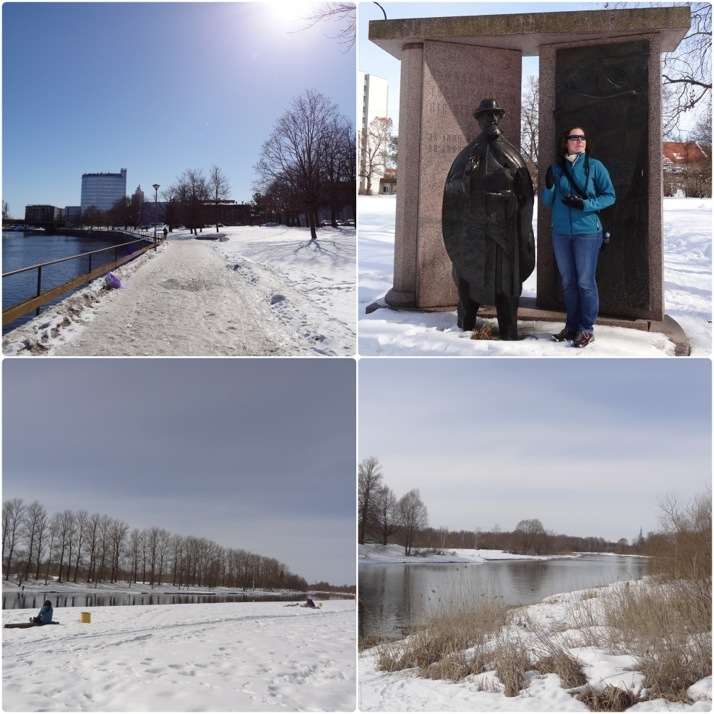 The bottom-left photo is of the beach. Yep, there’s sand under that snow..
The bottom-left photo is of the beach. Yep, there’s sand under that snow..
Tallinn
The bus journey to Tallinn was uneventful, which made a nice change!
Tallinn is lovely. It’s easy to forget there’s a lot of city outside the walls, especially as there’s so much to do and look at inside them. As soon as we’d dropped our bags off, we headed out to get our bearings in the old town and its cobbled streets.
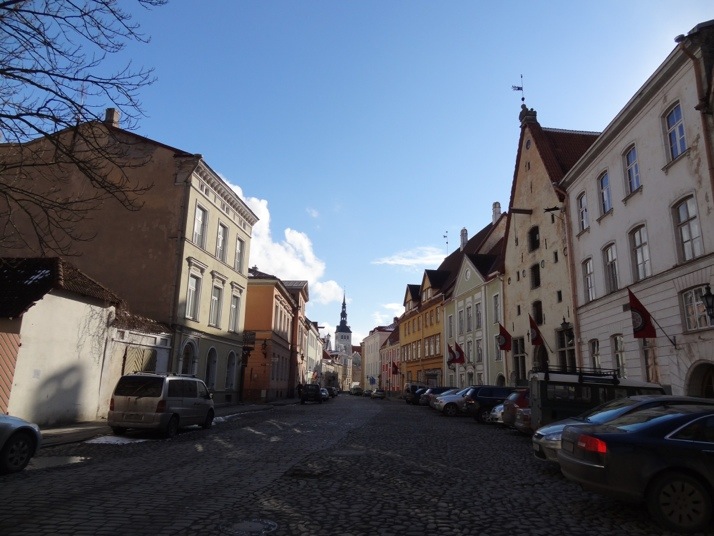 Pikk, towards the Raekoja plats (main square)
Pikk, towards the Raekoja plats (main square)
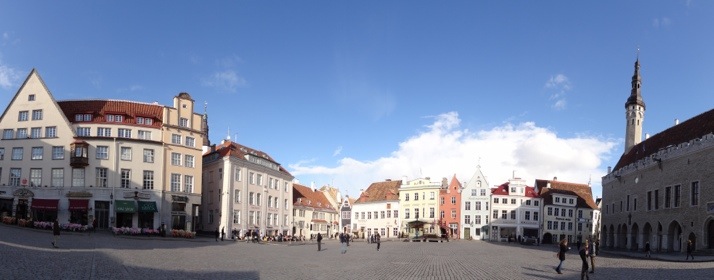 Raekoja plats. Town hall is on the right
Raekoja plats. Town hall is on the right
The second day we did a lot of walking. First, we did the Kultuurikilomeeter (Culture Kilometre) heading west past the old Patarei fortress prison which was closed – they have tours during the summer season, and the brand new sea-plane museum. Although the latter was open, we thought it seemed very expensive, as neither of us have a great interest in sea planes, except to have a go in one! We did walk around the building and take some photos of the outside exhibits though..
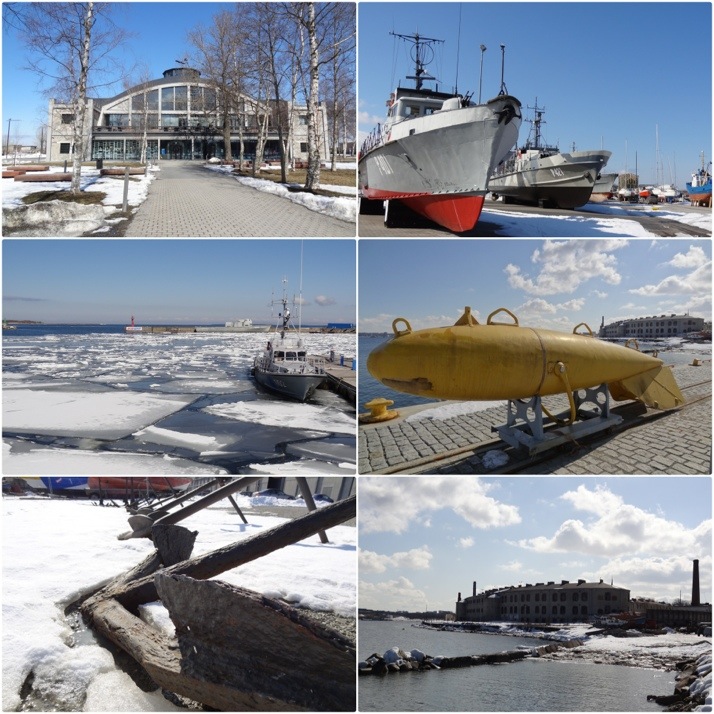 Bottom-right is the Patarei prison fortress. Any idea what the yellow thing is? – no visible hatch (so we don’t think its a submarine) nor pin on the nose or hole at the rear for propulsion that we could see (so maybe not a torpedo either?)
Bottom-right is the Patarei prison fortress. Any idea what the yellow thing is? – no visible hatch (so we don’t think its a submarine) nor pin on the nose or hole at the rear for propulsion that we could see (so maybe not a torpedo either?)
From the end of the Kultuurikilomeeter, we wandered through the old wooden house district, deciding which one we’d most like to live in. Some were quite dilapidated, and we later found out that some owners keep them that way deliberately, while some are only partly ‘neglected’ looking because they’re owned by two different people – one either has the money or the inclination to restore their half, and the other doesn’t!
On the way back we passed through the old Russian expat area, and braved the Russian market for some provisions. As well as the little indoor food halls, there are loads of stalls outside selling clothes, and quite a few bric-a-brac stalls selling old Soviet and Nazi memorabilia..
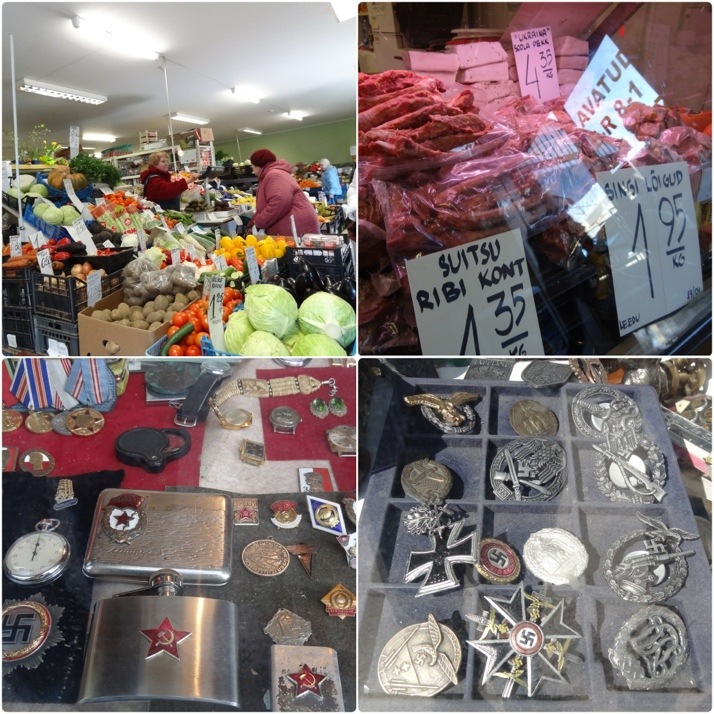
In the afternoon we went east past Hotel Viru – the only hotel visitors and foreigners were allowed to stay in during the Soviet era because the whole place was bugged by the KGB who had offices on the top floor – to Kadriorg Park, where the President’s Palace is to be found,
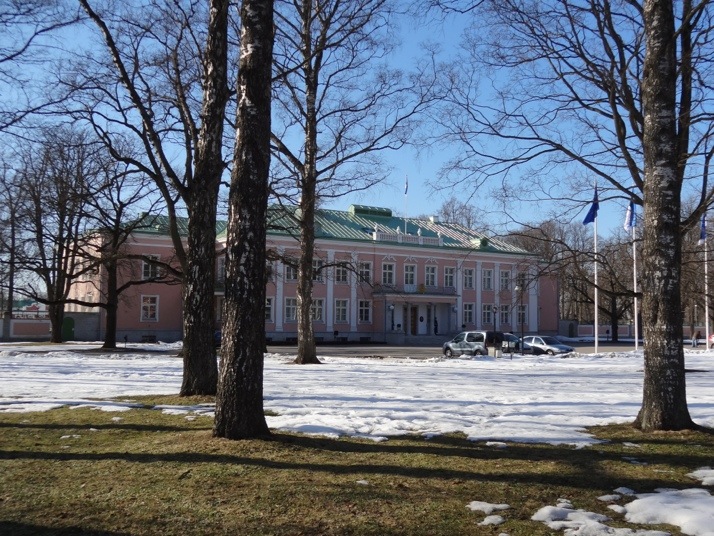 The Estonian President’s Palace
The Estonian President’s Palace
next door is the Kadriorg Art Museum, which, despite a chilly wind and about a foot of snow in places, it seems their gardens were still a good place to sunbathe..
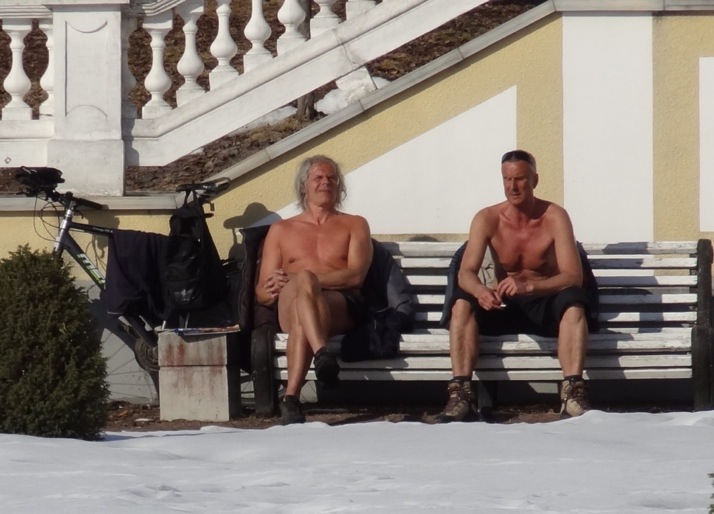 Wait, isn’t that Dr. Emmet Brown? “Marty! Marty!”
Wait, isn’t that Dr. Emmet Brown? “Marty! Marty!”
After a quick look at the outside of the very swanky Kumu (literally a shortened version of “art museum”) modern art museum building as they were closing, we headed towards the coastal path back towards the old town. On the way home we passed a large open stadium, and although it looked like it was full of seats, the seats were facing a gently sloping bank.. we wondered what kind of sport they played there because it wasn’t steep enough to get any decent speed, and it was surrounded by ticket offices, so it was obviously popular. We later found out it’s the Lauluväljak – the song festival grounds, where every 5 years they hold a massive singing festival. Mark 2014 in your calendars people!
The next day we took Julie’s jeans to a small shop to be mended, then joined the free city walking tour.
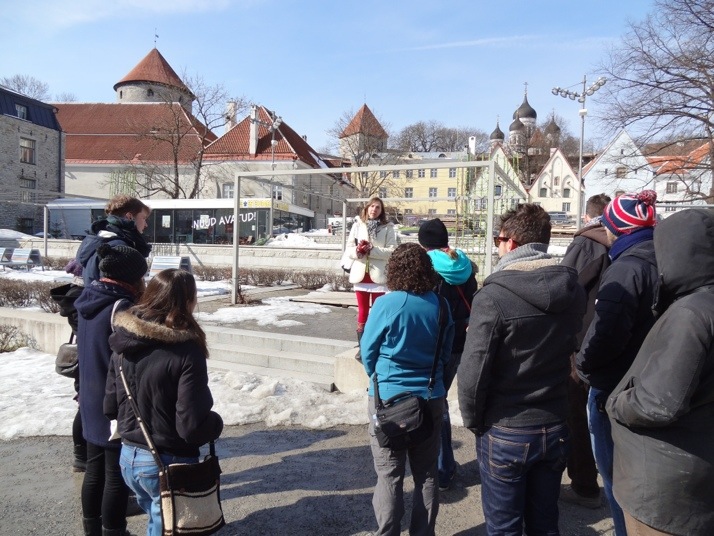 Annie, our guide explaining the history of Tallinn
Annie, our guide explaining the history of Tallinn
We were quite pleased to have found all of Annie’s favourite old town spots by ourselves in the days before, but it was still worth it for the commentary and a couple of places she pointed out on the way round that we decided to visit later, such as the oldest running pharmacy in Europe.
To warm ourselves up, we went to a little cafe that is known locally for its freshly made doughnuts – they were so good we had a second round (and an extra doughnut sneaked in!) ;o)
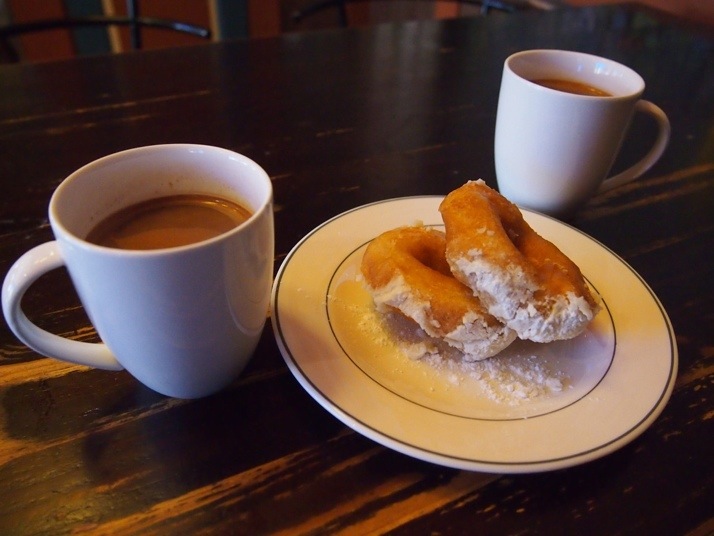
For our last full day in Tallinn, we decided to visit a few of the sights and check out the City Museum, as the latter had been closed when we tried it earlier in the week. First up, the excitingly named Mechanical Toy Museum.
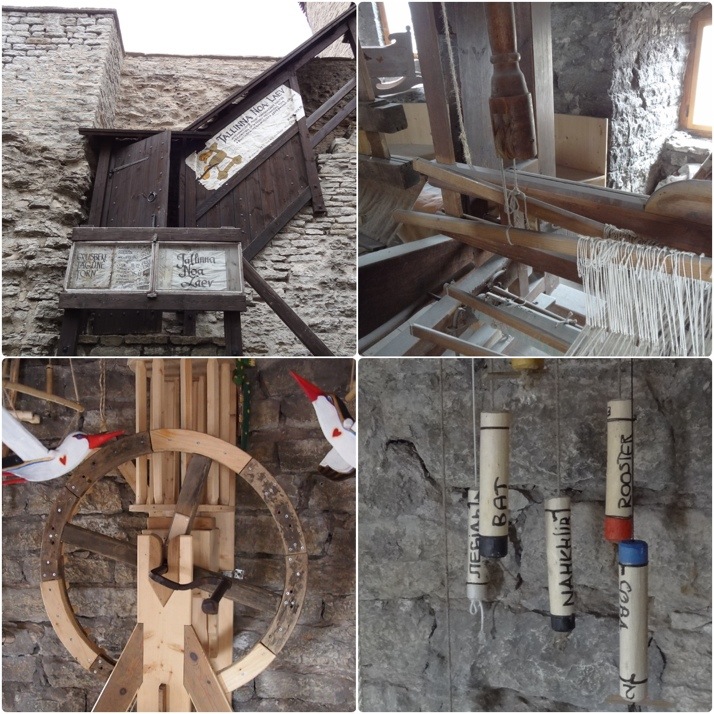
As we climbed the steps up to one of the old town wall towers, we imagined we’d find a treasure trove of wooden mechanical toys, curated by a wide-eyed, round-bellied, slightly disheveled but overly-enthusiastic grandad type, a sort of cross between the original Captain Birdseye and Oliver Hardy. He’d be delighted that you’d found the place and, like a small child trapped in an old man’s body, he’d proudly glow as he showed us through the Aladdins cave of moving toys, no sooner playing with one than moving to the next demonstrating what each one did and watching your face light up with the same childish enjoyment he gets from them, his youthfulness rejuvenated by our enjoyment of simple moving toys.
We were greeted by a young bored student girl surrounded by baby cots and two imposing weaving looms. Goodness knows how they got those looms up the stairs.
She promptly went up to the top floor and left us to admire the, er, looms. Never mind, there was still hope for our dreams of mechanical toys if there was an upstairs, of course they’d save the best stuff to the end!
Up the narrow spiral staircase and.. there are toys! Great, that’s more like it! Ahh but wait.. where’s Captain Hardy? Its a bit sparse too – where’s the cramped Aladdins cave we’d dreamt up? On closer inspection the toys are 4 showpieces from a carnival of some sort that look like they could still move, but all their strings are tied away and their wheels have had the cranks taken out. What a shame. The room was devoid of movement, and the toys weren’t really toys. It had so much potential. We left a couple of euros in the pot for the handmade postcards by way of sympathy to the reading student for having to sit in a cold mausoleum for dead ‘toys’.
Before we headed to the City Museum, we decided to get our ferry tickets to our next destination – Helsinki – and that also meant we could check out the bizarre Linnahall, a massive Soviet concrete structure that given its location, you’d be forgiven for thinking is a giant ferry terminal. On closer inspection, it’s dilapidated state tells you it hasn’t been in use for years.
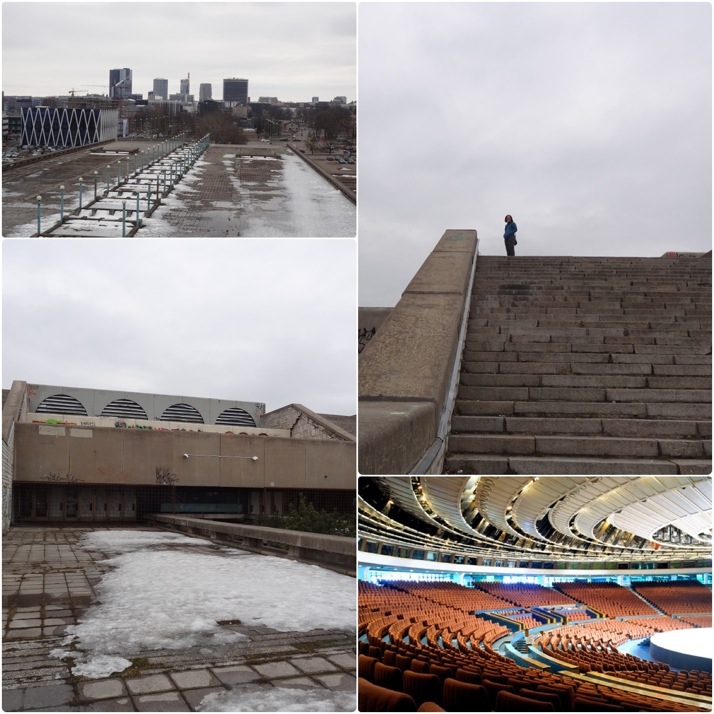 Bottom-right photo is of the concert hall inside, taken from the Linnahall website
Bottom-right photo is of the concert hall inside, taken from the Linnahall website
Ferry tickets in hand, we called into the Town Hall pharmacy, where we found a room of ye-olden-day remedies, check these out..
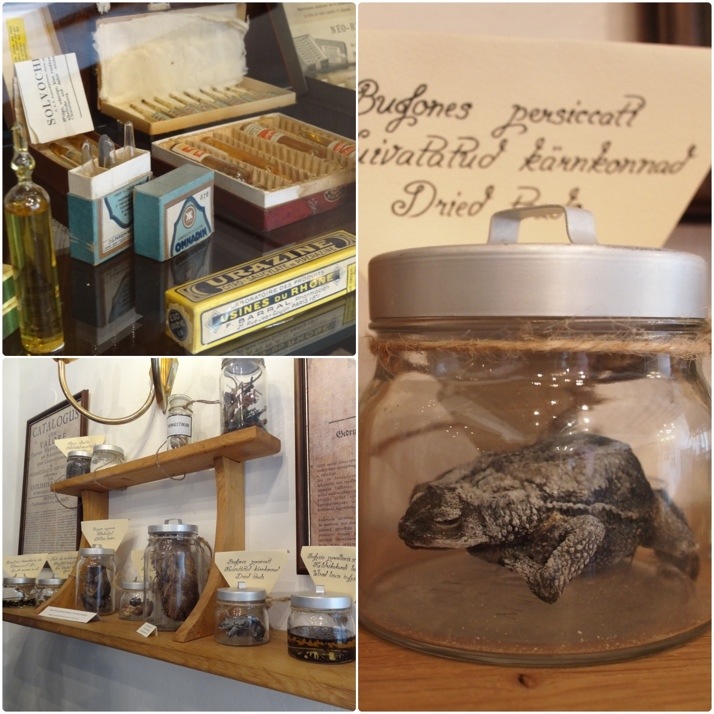 Yep, a dried toad. Other ingredients on the shelf included insects, a hedgehog, worms in oil, a stallion’s penis and dried dog feces
Yep, a dried toad. Other ingredients on the shelf included insects, a hedgehog, worms in oil, a stallion’s penis and dried dog feces
Next up, the excellent Tallinn City museum. Excellent for a few reasons: it’s in an old merchants trading house in the old town; not only does it cover the history of Tallinn, but dedicates a floor to the merchants guilds and the requirements to enter each of them (for example, to become a master of the carpentry guild you had to make 5 prescribed items in one day which were then assessed by the existing masters).
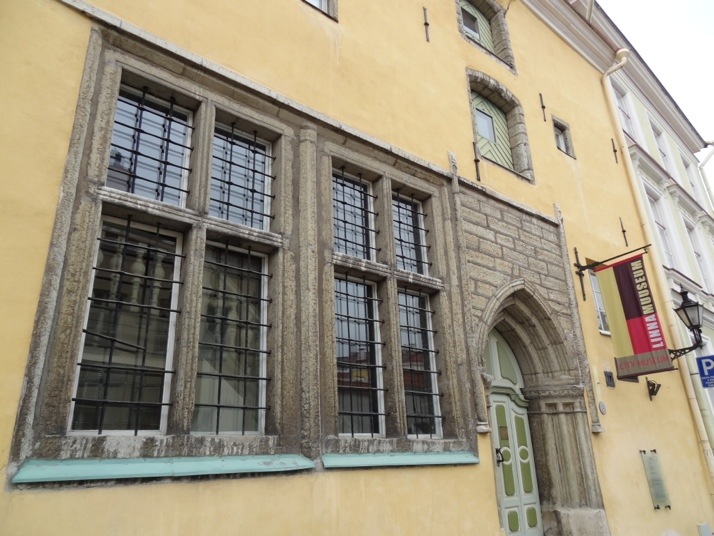 The excellent Tallinn City Museum
The excellent Tallinn City Museum
After a delicious meal out that was notable for the excellent food, superb service, and the first time we’ve seen a waiter reduced to fits of laughter by our neighbouring table – so much so that he was unable to return to them, twice! – we ventured out in the dark to get a picture of Estonia’s War of Independence Victory Column in Freedom Square, which lights up at night. I knew there was a reason for lugging a tripod around the world..
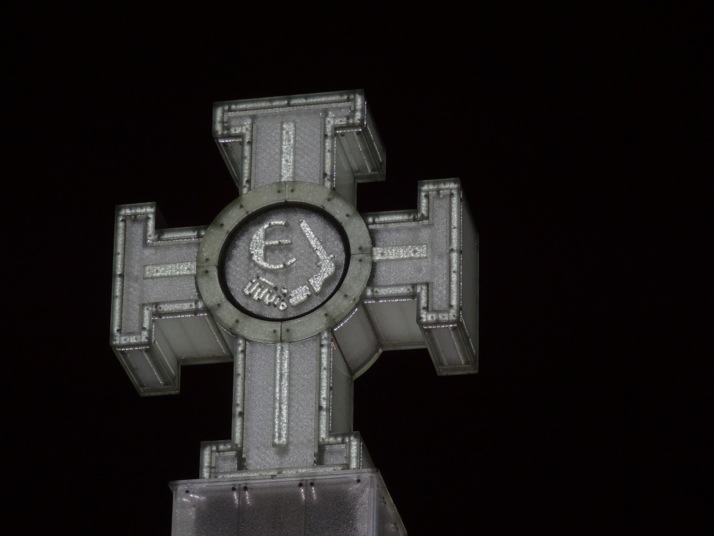 Thank you, Estonia
Thank you, Estonia
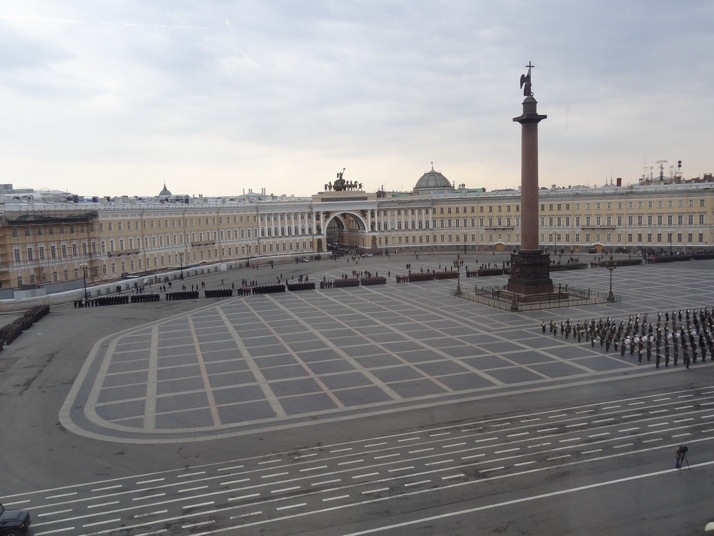 Palace Square and an unexplained military parade on the day of our first visit
Palace Square and an unexplained military parade on the day of our first visit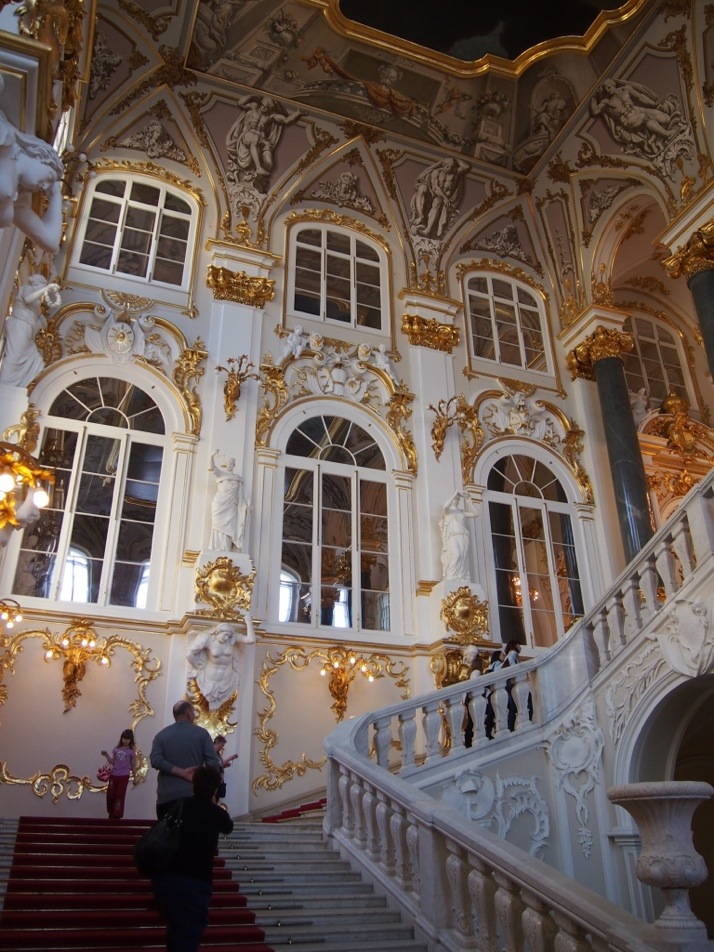 The Jordan staircase – what an entrance!
The Jordan staircase – what an entrance!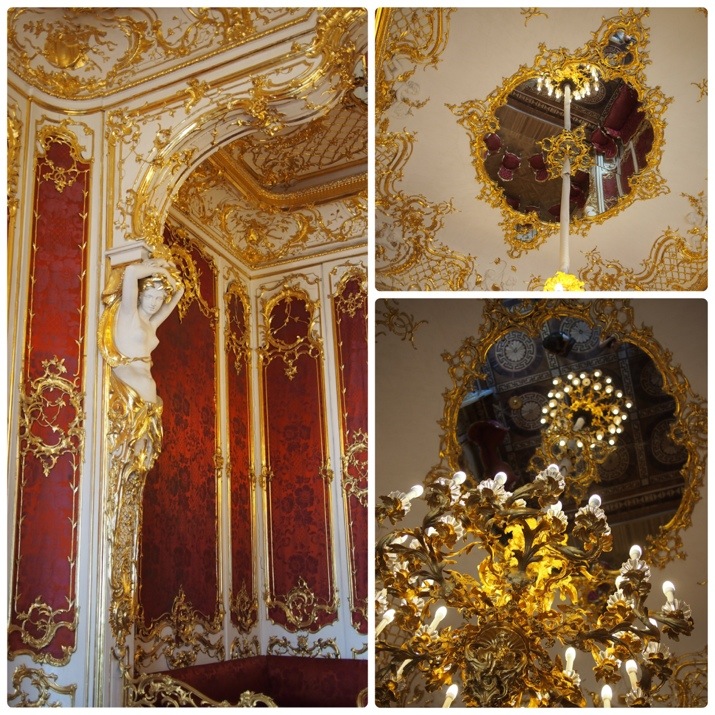 Lots of gilt and crimson in The Boudoir
Lots of gilt and crimson in The Boudoir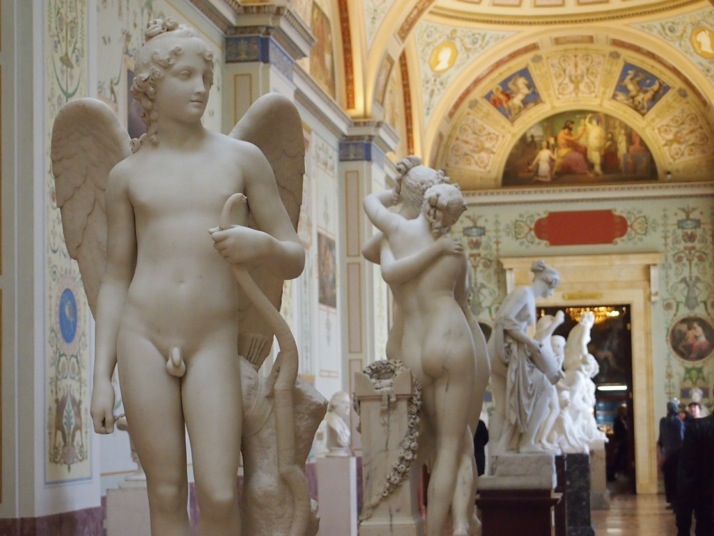 Sculptures in the Gallery of the History of Ancient Painting
Sculptures in the Gallery of the History of Ancient Painting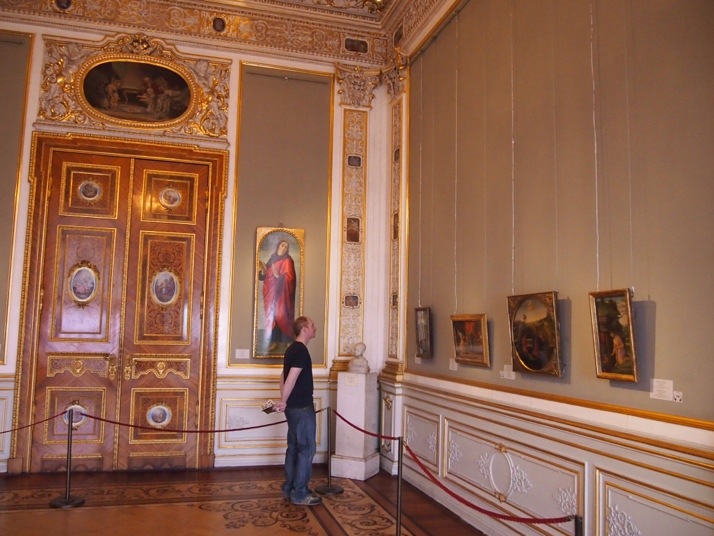 Italian art in impressive surroundings
Italian art in impressive surroundings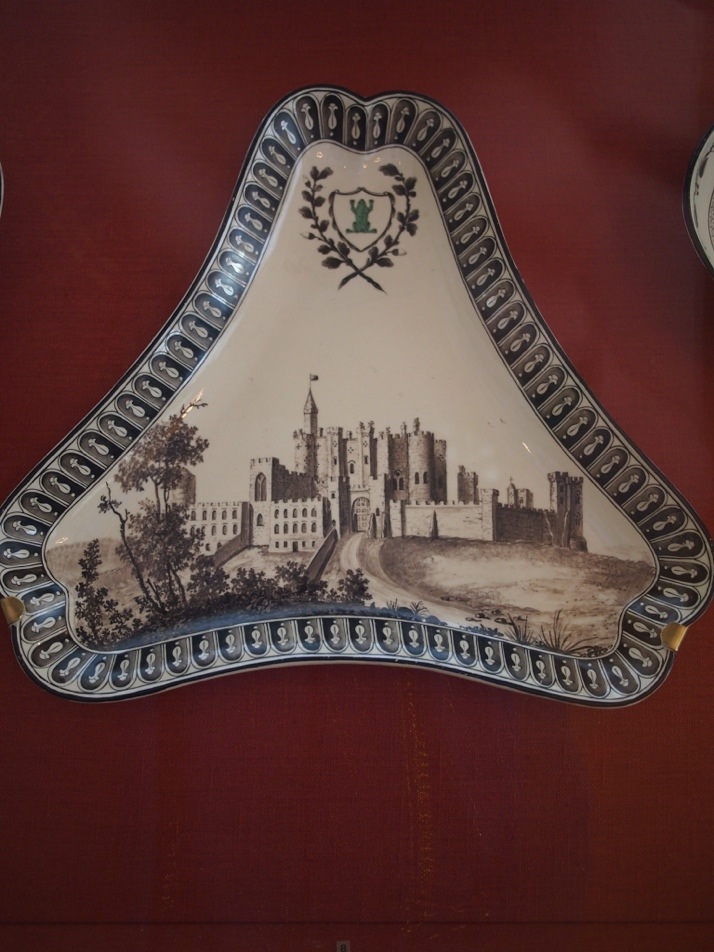 Triangular Wedgwood dish with a view of Alnwick Castle
Triangular Wedgwood dish with a view of Alnwick Castle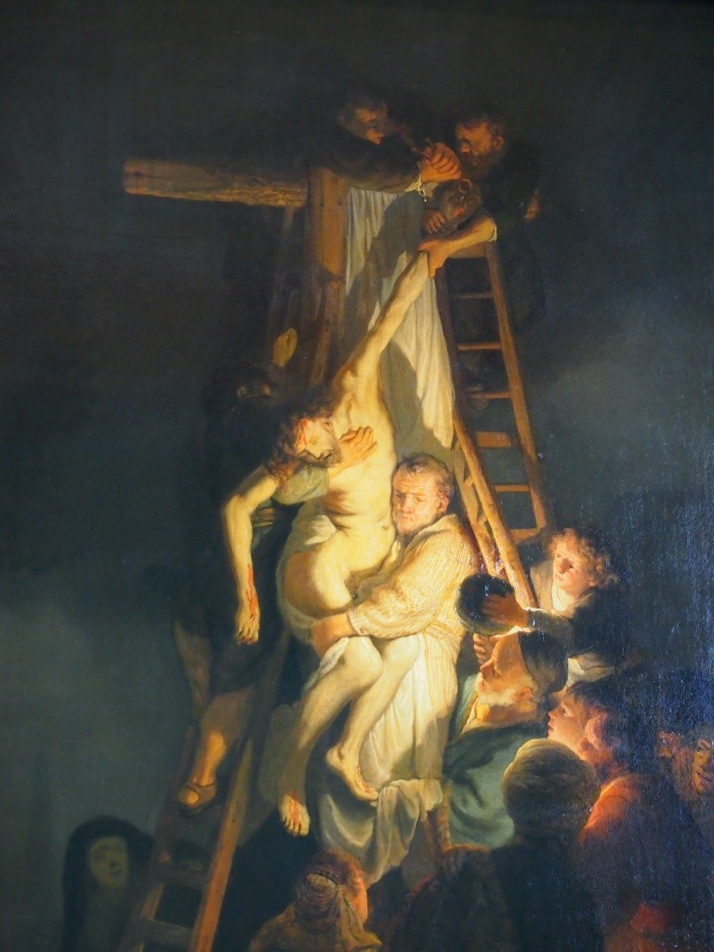 Rembrandt’s Descent from the Cross
Rembrandt’s Descent from the Cross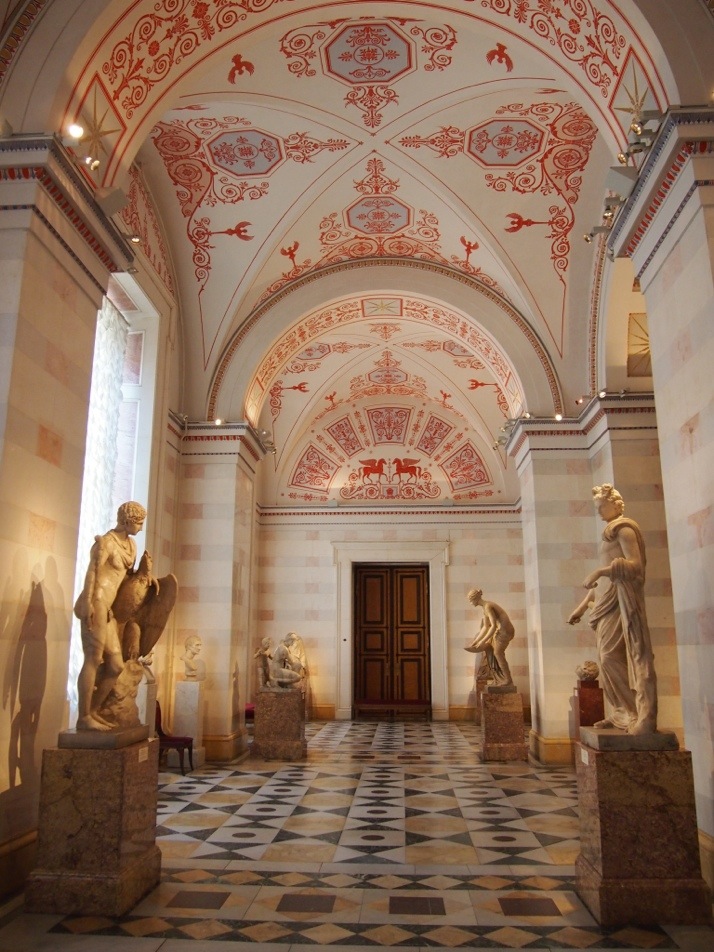 Room of the Culture and Art of the Hellenistic Era
Room of the Culture and Art of the Hellenistic Era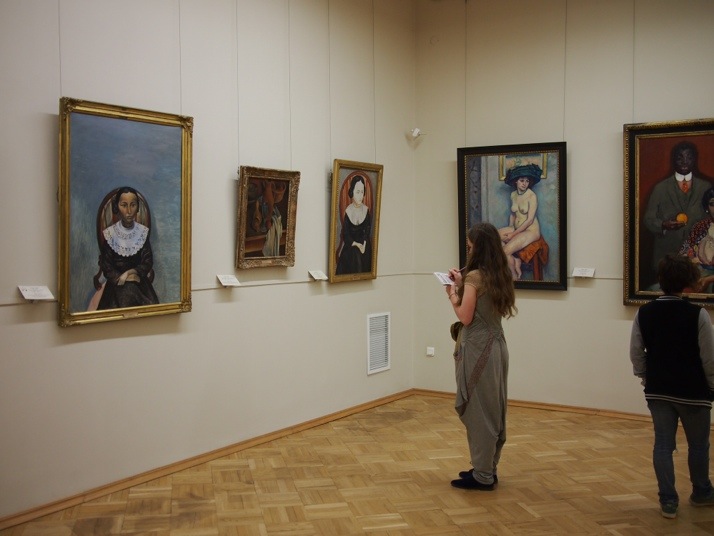 Art student sketching on the top floor
Art student sketching on the top floor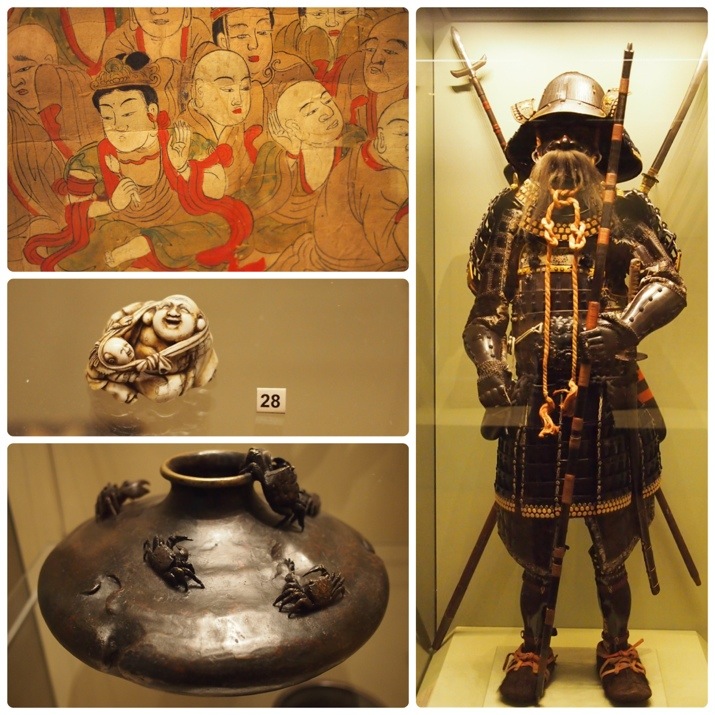 Pieces from the Japanese collection
Pieces from the Japanese collection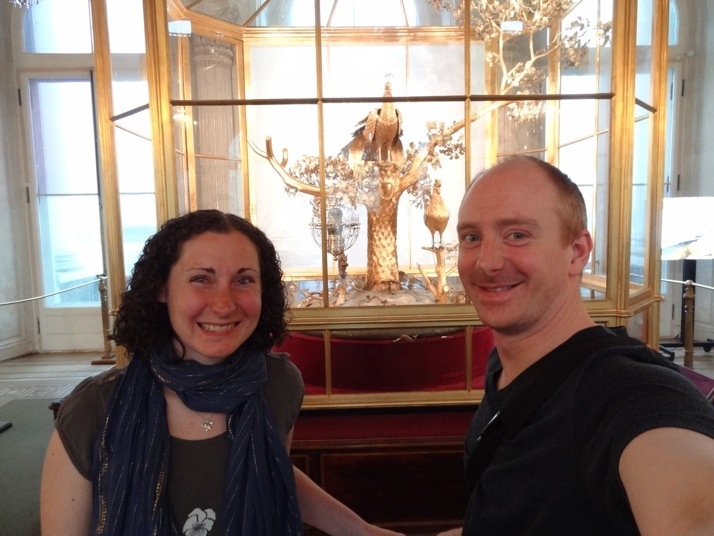 Us with the clock after the crowds had cleared
Us with the clock after the crowds had cleared
 two year trip
two year trip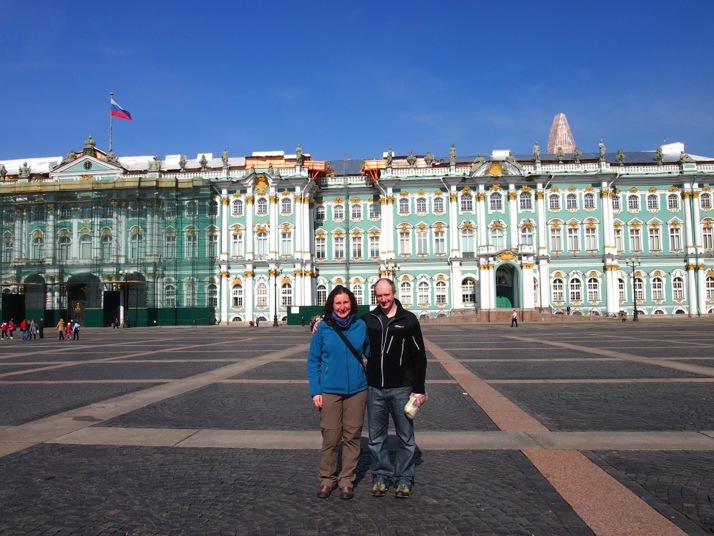
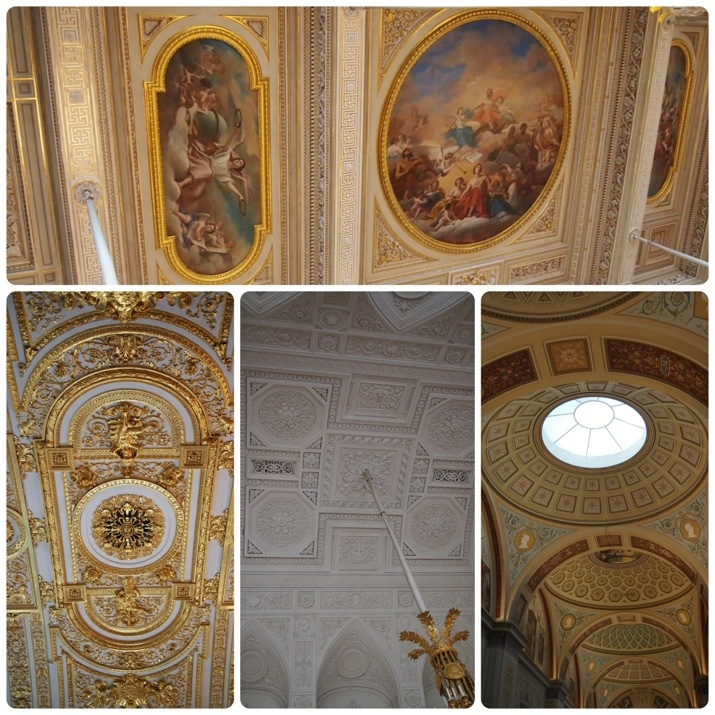
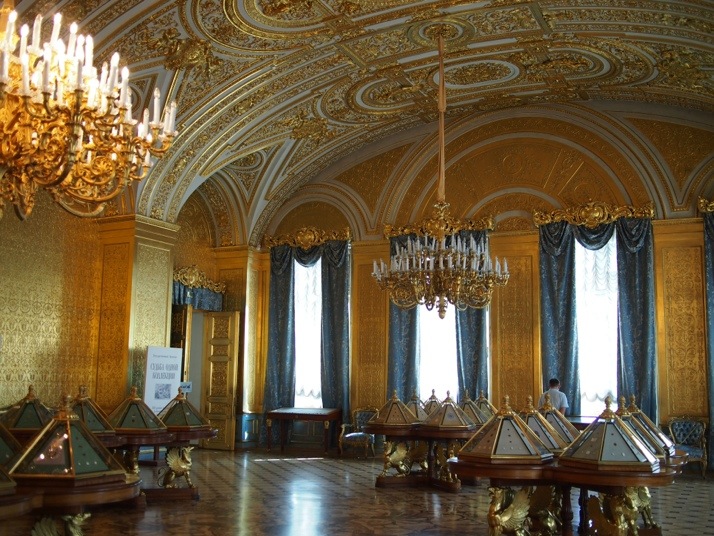
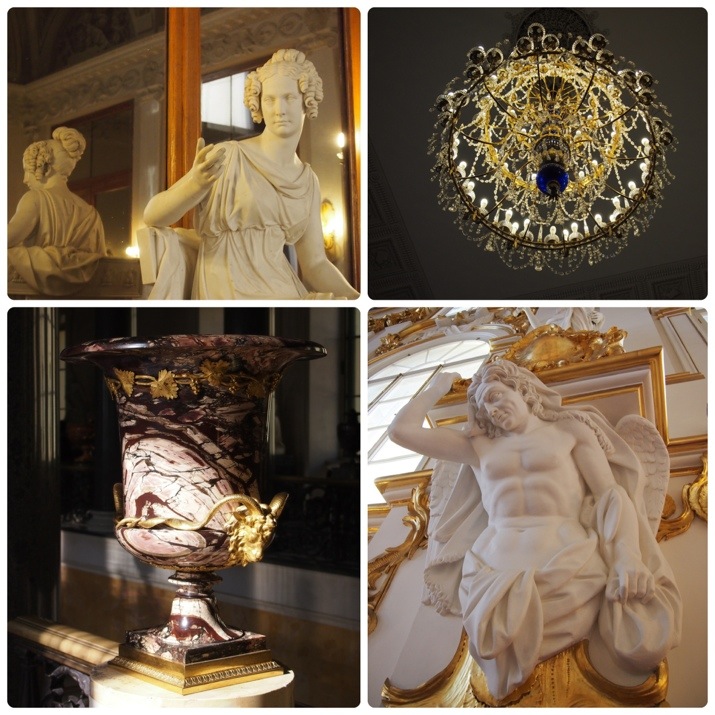
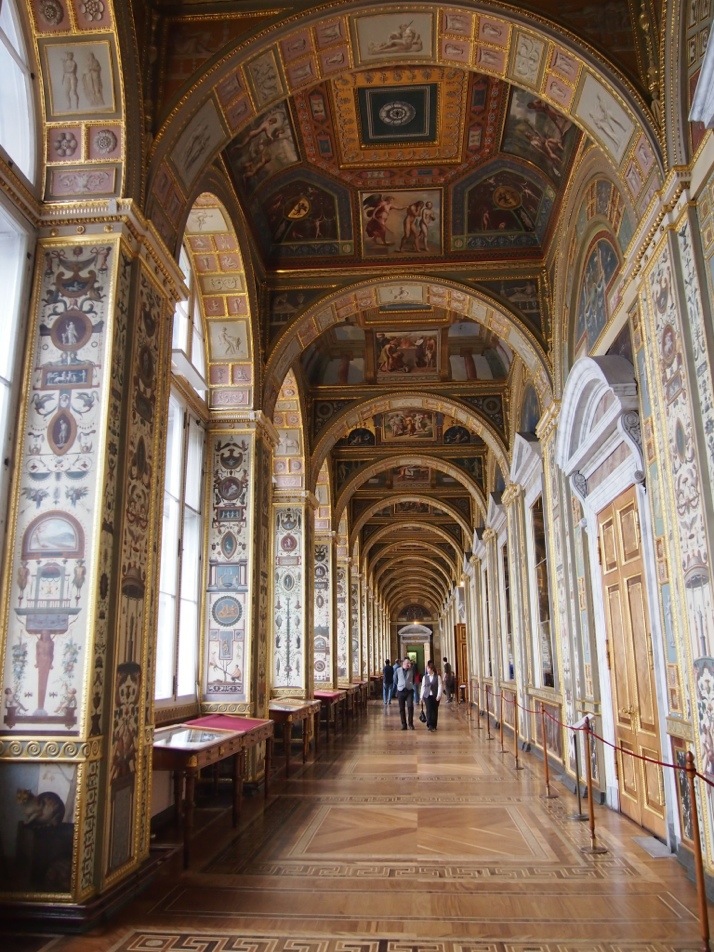
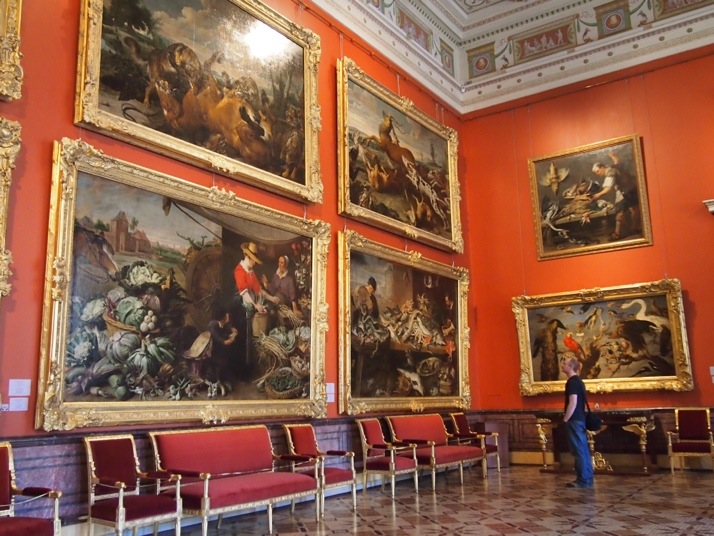
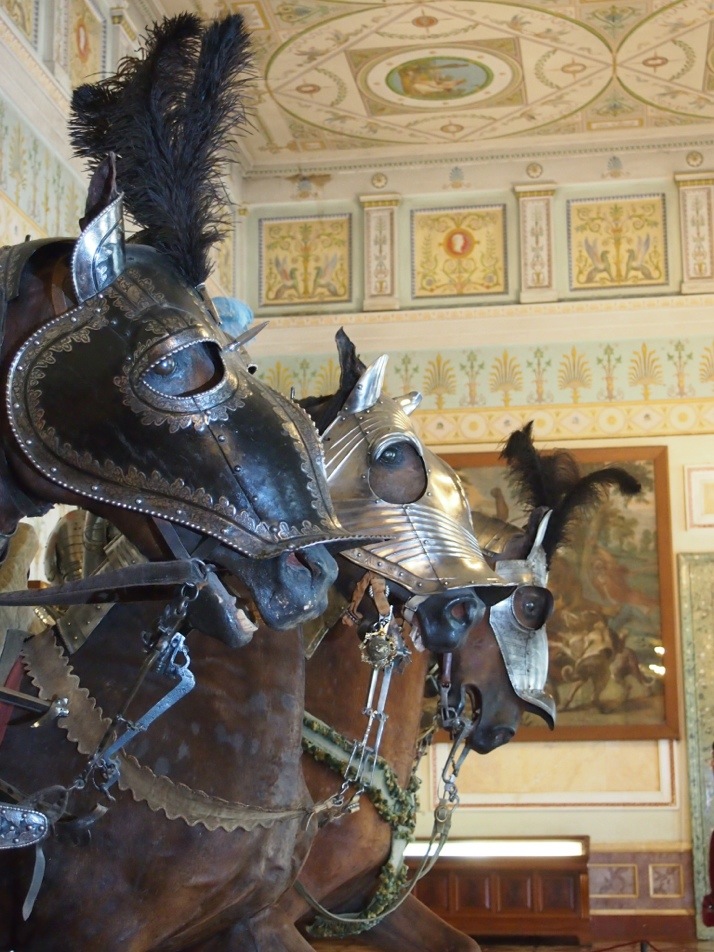
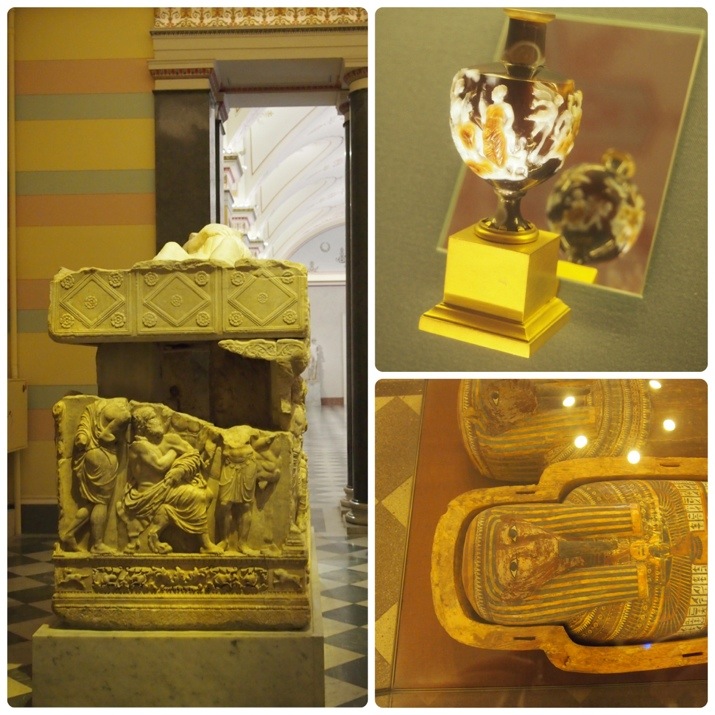
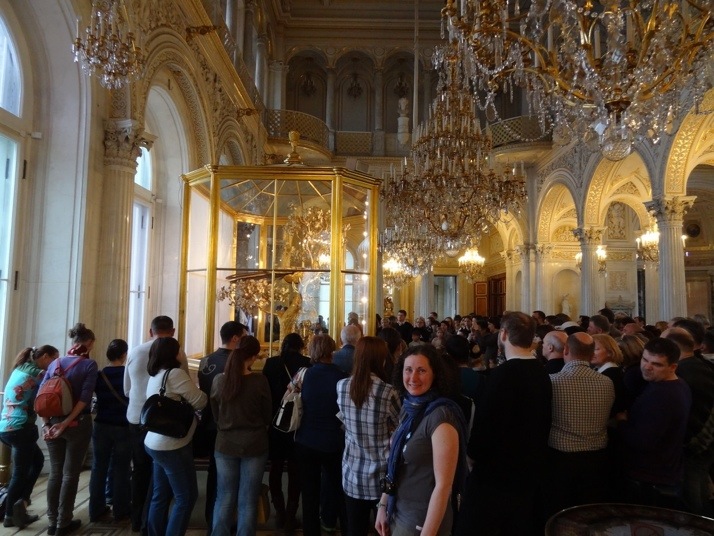


 Tartu indoor market. The pig outside sets the tone – most stalls sold pork, with 2 beef stands (that we saw), fruit, veg and sweet stuff on the periphery, and a small hall for fish – the most popular were small fish by the scoopfull!
Tartu indoor market. The pig outside sets the tone – most stalls sold pork, with 2 beef stands (that we saw), fruit, veg and sweet stuff on the periphery, and a small hall for fish – the most popular were small fish by the scoopfull!
 What you can’t see is the place is packed with locals, and there’s a Jean-Claude Van Damme movie playing on the TV.
What you can’t see is the place is packed with locals, and there’s a Jean-Claude Van Damme movie playing on the TV.

 Can you see the snow falling from the roof?
Can you see the snow falling from the roof? Sadly, the tower was closed as we like aerial views
Sadly, the tower was closed as we like aerial views
 Orchid collection especially for Moi :o)
Orchid collection especially for Moi :o)
 Torture chair left by the exiting KGB, and 2 solitary confinement rooms.
Torture chair left by the exiting KGB, and 2 solitary confinement rooms. For €100 you can have your own tankard put on a peg behind the bar too.. I was very tempted..
For €100 you can have your own tankard put on a peg behind the bar too.. I was very tempted.. The bottom-left photo is of the beach. Yep, there’s sand under that snow..
The bottom-left photo is of the beach. Yep, there’s sand under that snow.. Pikk, towards the Raekoja plats (main square)
Pikk, towards the Raekoja plats (main square) Raekoja plats. Town hall is on the right
Raekoja plats. Town hall is on the right Bottom-right is the Patarei prison fortress. Any idea what the yellow thing is? – no visible hatch (so we don’t think its a submarine) nor pin on the nose or hole at the rear for propulsion that we could see (so maybe not a torpedo either?)
Bottom-right is the Patarei prison fortress. Any idea what the yellow thing is? – no visible hatch (so we don’t think its a submarine) nor pin on the nose or hole at the rear for propulsion that we could see (so maybe not a torpedo either?)
 The Estonian President’s Palace
The Estonian President’s Palace Wait, isn’t that Dr. Emmet Brown? “Marty! Marty!”
Wait, isn’t that Dr. Emmet Brown? “Marty! Marty!” Annie, our guide explaining the history of Tallinn
Annie, our guide explaining the history of Tallinn

 Bottom-right photo is of the concert hall inside, taken from the
Bottom-right photo is of the concert hall inside, taken from the  Yep, a dried toad. Other ingredients on the shelf included insects, a hedgehog, worms in oil, a stallion’s penis and dried dog feces
Yep, a dried toad. Other ingredients on the shelf included insects, a hedgehog, worms in oil, a stallion’s penis and dried dog feces The excellent Tallinn City Museum
The excellent Tallinn City Museum Thank you, Estonia
Thank you, Estonia